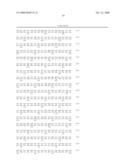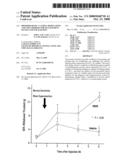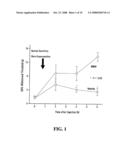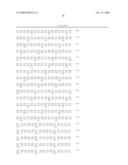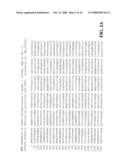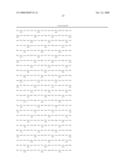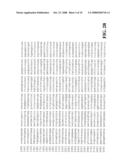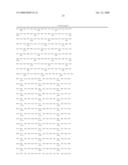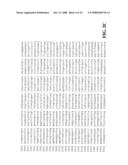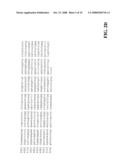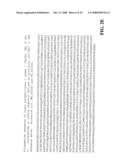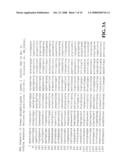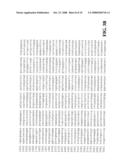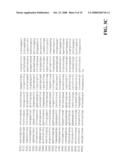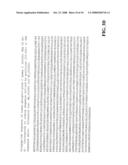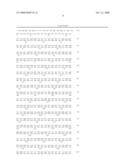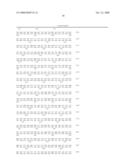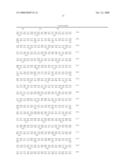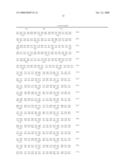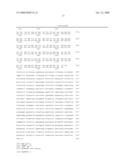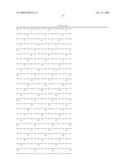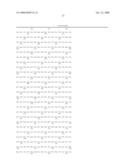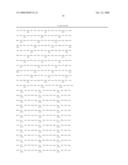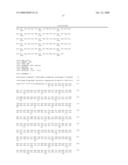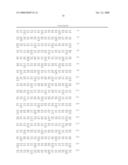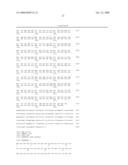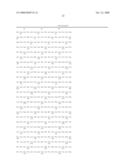Patent application title: Phospholipase C Gamma Modulation and Uses Thereof for Management of Pain and Nociception
Inventors:
Jeffrey A.m. Coull (Toronto, CA)
Yves De Koninck (Ste-Foy, CA)
IPC8 Class: AA61K3121FI
USPC Class:
4241301
Class name: Drug, bio-affecting and body treating compositions immunoglobulin, antiserum, antibody, or antibody fragment, except conjugate or complex of the same with nonimmunoglobulin material
Publication date: 2008-10-23
Patent application number: 20080260718
Claims:
1. A method of treating or preventing pain in a subject, the method
comprising inhibiting activity or expression of a phospholipase C gamma
(PLC.sub.γ) in the subject.
2. The method of claim 1, wherein said subject is a human.
3. The method of claim 1, wherein the method comprises inhibiting activity or expression of a PLC.sub.γ in a central nervous system (CNS) cell or tissue.
4. The method of claim 3, wherein the CNS cell or tissue is a spinal cord cell or tissue.
5. The method of claim 3, wherein a pain signal originates in a peripheral nervous system (PNS) cell or sensory fiber transsynaptic to the CNS cell.
6. The method of claim 1, wherein the pain is neuropathic pain.
7. The method of claim 6, wherein the neuropathic pain is associated with a nerve or tract injury.
8. The method of claim 6, wherein the neuropathic pain is selected from the group consisting of somatic and visceral pain.
9. The method of claim 1, wherein the pain is selected from the group consisting of chronic inflammatory pain, pain associated with arthritis, fibromyalgia, back pain, cancer-associated pain, pain associated with digestive disease, pain associated with Crohn's disease, pain associated with autoimmune disease, pain associated with endocrine disease, pain associated with diabetic neuropathy, phantom limb pain, spontaneous pain, chronic post-surgical pain, chronic temporomandibular pain, causalgia, post-herpetic neuralgia, AIDS-related pain, complex regional pain syndromes type I and II, trigeminal neuralgia, chronic back pain, pain associated with spinal cord injury and recurrent acute pain.
10. A method of treating or preventing pain in a subject, the method comprising administering to the subject an agent capable of inhibiting activity or expression of a PLC.sub.γ in the subject or a composition comprising an agent capable of inhibiting activity or expression of a PLC.sub.γ in the subject and a pharmaceutically acceptable carrier.
11. The method of claim 10, wherein the agent is a PLC.sub.γ inhibitor.
12. The method of claim 11, wherein the PLC.sub.γ inhibitor is selected from the group consisting of tricyclodecan-9-yl-xanthogenate, 1-O-octadecyl-2-O-methyl-rac-glycero-3-phosphorylcholine, neomycin sulfate, spermine tetrahydrochloride, 1-[6-((17beta-3-methoxyestra-1,3,5(10)-trien-17-yl)amino)hexyl]-1H-pyrrol- e-2,5-dione, and 1-[6-((17beta-3-methoxyestra-1,3,5(10)-trien-17-yl)amino)hexyl]-2,5-pyrro- lidinedione.
13. The method of claim 11, wherein the PLC.sub.γ inhibitor is tricyclodecan-9-yl-xanthogenate.
14. The method of claim 10, wherein the agent is an anti-PLC.sub.γ antibody.
15. The method of claim 10, wherein the agent is selected from an antisense molecule, a ribozyme, a siRNA, a siRNA-like molecule, and an inhibitor of binding of a ligand to the PLC.sub.γ.
16. The method of claim 15, wherein the antisense molecule is a nucleic acid that is substantially complementary to a portion of an mRNA encoding PLC.sub.γ.
17-22. (canceled)
23. The method of claim 10, wherein the method comprises inhibiting activity or expression of a PLC.sub.γ in a CNS cell or tissue.
24. The method of claim 23, wherein the CNS cell or tissue is a spinal cord cell or tissue.
25. The method of claim 23, wherein a pain signal originates in a PNS cell or sensory fiber transsynaptic to the CNS cell.
26. The method of claim 10, wherein the pain is neuropathic pain.
27. The method of claim 26, wherein the neuropathic pain is associated with a nerve or tract injury.
28. The method of claim 26, wherein the neuropathic pain is selected from the group consisting of somatic and visceral pain.
29. The method of claim 10, wherein the pain is selected from the group consisting of chronic inflammatory pain, pain associated with arthritis, fibromyalgia, back pain, cancer-associated pain, pain associated with digestive disease, pain associated with Crohn's disease, pain associated with autoimmune disease, pain associated with endocrine disease, pain associated with diabetic neuropathy, phantom limb pain, spontaneous pain, chronic post-surgical pain, chronic temporomandibular pain, causalgia, post-herpetic neuralgia, AIDS-related pain, complex regional pain syndromes type I and II, trigeminal neuralgia, chronic back pain, pain associated with spinal cord injury and recurrent acute pain.
30-43. (canceled)
44. A composition for treatment or prevention of pain in a subject, comprising:an agent capable of inhibiting activity or expression of a PLC.sub.γ in the subject; anda pharmaceutically acceptable carrier.
45. The composition of claim 44, wherein the agent is a PLC.sub.γ inhibitor.
46. The composition of claim 45, wherein the PLC.sub.γ inhibitor is selected from the group consisting of tricyclodecan-9-yl-xanthogenate, 1-O-octadecyl-2-O-methyl-rac-glycero-3-phosphorylcholine, neomycin sulfate, spermine tetrahydrochloride, 1-[6-((17beta-3-methoxyestra-1,3,5(10)-trien-17-yl)amino)hexyl]-1H-pyrrol- e-2,5-dione, and 1-[6-((17beta-3-methoxyestra-1,3,5(10)-trien-17-yl)amino)hexyl]-2,5-pyrro- lidinedione.
47. The composition of claim 45, wherein the PLC.sub.γ inhibitor is tricyclodecan-9-yl-xanthogenate.
48. The composition of claim 46, wherein the agent is an anti-PLC.sub.γ antibody.
49. The composition of claim 46, wherein the agent is selected from an antisense molecule, a ribozyme, a siRNA, a siRNA-like molecule, and an inhibitor of binding of a ligand to the PLC.sub.γ.
50. The composition of claim 49, wherein the antisense molecule is a nucleic acid that is substantially complementary to a portion of an mRNA encoding PLC.sub.γ.
51. The composition of claim 44, wherein the agent is capable of inhibiting activity or expression of a PLC.sub.γ in a CNS cell or tissue.
52. The composition of claim 51, wherein the CNS cell or tissue is a spinal cord cell or tissue.
53. The composition of claim 51, wherein a pain signal originates in a PNS cell or sensory fiber transsynaptic to the CNS cell.
54. The composition of claim 44, wherein the pain is neuropathic pain.
55. The composition of claim 54, wherein the neuropathic pain is associated with a nerve or tract injury.
56. The composition of claim 54, wherein the neuropathic pain is selected from the group consisting of somatic and visceral pain.
57. The composition of claim 44, wherein the pain is selected from the group consisting of chronic inflammatory pain, pain associated with arthritis, fibromyalgia, back pain, cancer-associated pain, pain associated with digestive disease, pain associated with Crohn's disease, pain associated with autoimmune disease, pain associated with endocrine disease, pain associated with diabetic neuropathy, phantom limb pain, spontaneous pain, chronic post-surgical pain, chronic temporomandibular pain, causalgia, post-herpetic neuralgia, AIDS-related pain, complex regional pain syndromes type I and II, trigeminal neuralgia, chronic back pain, pain associated with spinal cord injury and recurrent acute pain.
58. A package comprising an agent capable of inhibiting activity or expression of a PLC.sub.γ in a subject or a composition comprising an agent capable of inhibiting activity or expression of a PLC.sub.γ in a subject and a pharmaceutically acceptable carrier, together with instructions for use of the agent or composition in the treatment or prevention of pain.
59. The package of claim 58, wherein the agent is a PLC.sub.γ inhibitor.
60. The package of claim 59, wherein the PLC.sub.γ inhibitor is selected from the group consisting of tricyclodecan-9-yl-xanthogenate, 1-O-octadecyl-2-O-methyl-rac-glycero-3-phosphorylcholine, neomycin sulfate, spermine tetrahydrochloride, 1-[6-((17beta-3-methoxyestra-1,3,5(10)-trien-17-yl)amino)hexyl]-1H-pyrrol- e-2,5-dione, and 1-[6-((17beta-3-methoxyestra-1,3,5(10)-trien-17-yl)amino)hexyl]-2,5-pyrro- lidinedione.
61. The package of claim 59, wherein the PLC.sub.γ inhibitor is tricyclodecan-9-yl-xanthogenate.
62. The package of claim 59, wherein the agent is an anti-PLC.sub.γ antibody.
63. The package of claim 59, wherein the agent is selected from an antisense molecule, a ribozyme, a siRNA, a siRNA-like molecule, and an inhibitor of binding of a ligand to the PLC.sub.γ.
64. The package of claim 63, wherein the antisense molecule is a nucleic acid that is substantially complementary to a portion of an mRNA encoding PLC.sub.γ.
65. The package of claim 59, wherein the agent is capable of inhibiting activity or expression of a PLC.sub.γ in a CNS cell or tissue.
66. The package of claim 65, wherein the CNS cell or tissue is a spinal cord cell or tissue.
67. The package of claim 65, wherein a pain signal originates in a PNS cell or sensory fiber transsynaptic to the CNS cell.
68. The package of claim 59, wherein the pain is neuropathic pain.
69. The package of claim 68, wherein the neuropathic pain is associated with a nerve or tract injury.
70. The package of claim 68, wherein the neuropathic pain is selected from the group consisting of somatic and visceral pain.
71. The package of claim 58, wherein the pain is selected from the group consisting of chronic inflammatory pain, pain associated with arthritis, fibromyalgia, back pain, cancer-associated pain, pain associated with digestive disease, pain associated with Crohn's disease, pain associated with autoimmune disease, pain associated with endocrine disease, pain associated with diabetic neuropathy, phantom limb pain, spontaneous pain, chronic post-surgical pain, chronic temporomandibular pain, causalgia, post-herpetic neuralgia, AIDS-related pain, complex regional pain syndromes type I and II, trigeminal neuralgia, chronic back pain, pain associated with spinal cord injury and recurrent acute pain.
72-127. (canceled)
128. A method of identifying or characterizing an agent for treatment or prevention of pain, comprising:contacting the agent with a cell having an activity or expression of a PLC.sub.γ; anddetermining whether there is inhibition of the activity or expression of a PLC.sub.γ in the presence of the agent;wherein the inhibition is an indication that the agent may be used for treatment or prevention of pain.
129. A method of identifying or characterizing an agent for treatment or prevention of pain, comprising:contacting the agent with a PLC.sub.γ; anddetermining whether there is inhibition of the activity of the PLC.sub.γ in the presence of the agent;wherein the inhibition is an indication that the agent may be used for treatment or prevention of pain.
130. The method of claim 128, wherein the method comprises determining whether there is inhibition of the activity or expression of a PLC.sub.γ in a CNS cell or tissue.
131. The method of claim 130, wherein the CNS cell or tissue is a spinal cord cell or tissue.
132. The method of claim 130, wherein a pain signal originates in a PNS cell or sensory fiber transsynaptic to the CNS cell.
133. The method of claim 128, wherein the pain is neuropathic pain.
134. The method of claim 133, wherein the neuropathic pain is associated with a nerve or tract injury.
135. The method of claim 133, wherein the neuropathic pain is selected from the group consisting of somatic and visceral pain.
136. The method of claim 128, wherein the pain is selected from the group consisting of chronic inflammatory pain, pain associated with arthritis, fibromyalgia, back pain, cancer-associated pain, pain associated with digestive disease, pain associated with Crohn's disease, pain associated with autoimmune disease, pain associated with endocrine disease, pain associated with diabetic neuropathy, phantom limb pain, spontaneous pain, chronic post-surgical pain, chronic temporomandibular pain, causalgia, post-herpetic neuralgia, AIDS-related pain, complex regional pain syndromes type I and II, trigeminal neuralgia, chronic back pain, pain associated with spinal cord injury and recurrent acute pain.
137. A method for decreasing nociception in a subject, comprising inhibiting activity or expression of a PLC.sub.γ in the subject.
138. The method of claim 137, wherein said subject is a human.
139. The method of claim 137, wherein the method comprises inhibiting activity or expression of a PLC.sub.γ in a CNS cell or tissue.
140. The method of claim 139, wherein the CNS cell or tissue is a spinal cord cell or tissue.
141. A method for decreasing nociception in a subject, comprising administering to the subject an agent capable of inhibiting activity or expression of a PLC.sub.γ in the subject or a composition comprising an agent capable of inhibiting activity or expression of a PLC.sub.γ in the subject and a pharmaceutically acceptable carrier.
142. The method of claim 141, wherein the agent is a PLC.sub.γ inhibitor.
143. The method of claim 142, wherein the PLC.sub.γ inhibitor is selected from the group consisting of tricyclodecan-9-yl-xanthogenate, 1-O-octadecyl-2-O-methyl-rac-glycero-3-phosphorylcholine, neomycin sulfate, spermine tetrahydrochloride, 1-[6-((17beta-3-methoxyestra-1,3,5(10)-trien-17-yl)amino)hexyl]-1H-pyrrol- e-2,5-dione, and 1-[6-((17beta-3-methoxyestra-1,3,5(10)-trien-17-yl)amino)hexyl]-2,5-pyrro- lidinedione.
144. The method of claim 142, wherein the PLC.sub.γ inhibitor is tricyclodecan-9-yl-xanthogenate.
145. The method of claim 142, wherein the agent is an anti-PLC.sub.γ antibody.
146. The method of claim 142, wherein the agent is selected from an antisense molecule, a ribozyme, a siRNA, a siRNA-like molecule, and an inhibitor of binding of a ligand to the PLC.sub.γ.
147. The method of claim 146, wherein the antisense molecule is a nucleic acid that is substantially complementary to a portion of an mRNA encoding PLC.sub.γ.
148. The method of claim 141, wherein the method comprises inhibiting activity or expression of a PLC.sub.γ in CNS cell or tissue.
149. The method of claim 148, wherein the CNS cell or tissue is a spinal cord cell or tissue.
150-158. (canceled)
159. A method of identifying or characterizing a compound for treatment or prevention of pain, said method comprising:(a) contacting a test compound with a cell comprising a first nucleic acid comprising a transcriptionally regulatory element normally associated with a PLC.sub.Γ gene, operably linked to a second nucleic acid comprising a reporter gene capable of encoding a reporter protein; and(b) determining whether reporter gene expression or reporter protein activity is decreased in the presence of said test compound;wherein said decrease in reporter gene expression or reporter protein activity being is an indication that said test compound may be used for treatment or prevention of pain.
160. The method of claim 159, wherein said cell is a CNS-derived cell.
161. A method of identifying or characterizing an agent for treatment or prevention of pain, comprising:contacting the agent and a PLC.sub.Γ ligand with a cell comprising a PLC.sub.γ; anddetermining whether there is a decrease of the binding of the ligand to the PLC.sub.γ in the presence of the agent;wherein the decrease is an indication that the agent may be used for treatment or prevention of pain.
162. The method of claim 161, wherein said cell is a CNS-derived cell.
163. A method of identifying or characterizing an agent for treatment or prevention of pain, comprising:contacting the agent and a PLC.sub.Γ ligand with a PLC.sub.γ; anddetermining whether there is decrease of the binding of the ligand to the PLC.sub.γ in the presence of the agent;wherein the decrease is an indication that the agent may be used for treatment or prevention of pain.
164-179. (canceled)
Description:
FIELD OF THE INVENTION
[0001]The invention relates to the modulation of activity, function and/or expression of phospholipase C gamma (PLC.sub.γ) in a subject and uses thereof, such as for treating and preventing and pain.
BACKGROUND OF THE INVENTION
[0002]The need for new and improved methods and agents for pain treatment is a significant ongoing concern in medicine. Acute pain, e.g. related to injury or disease, can be severe and have critical effects on patient recovery. An even greater concern is chronic pain, which affects a large proportion of the population, causing not only significant discomfort, but can result in low self-esteem, depression, anger, and can interfere with or completely prevent a sufferer from typical daily activities.
[0003]While a number of studies have been done in this area, many mechanisms and pathways involved in pain sensation remain poorly understood. There remains a continued need to provide new strategies of therapeutic intervention for pain treatment.
SUMMARY OF THE INVENTION
[0004]The invention relates to methods of treating and/or preventing pain. The invention further relates to methods of modulating (e.g. inhibiting) activity, expression, and/or function of a phospholipase C gamma (PLC.sub.γ) in a subject.
[0005]According to one aspect of the present invention, there is provided a method of treating or preventing pain in a subject, the method comprising modulating activity, function and/or expression of a PLC.sub.γ in the subject.
[0006]According to another aspect of the present invention, there is provided a method of treating or preventing pain in a subject, the method comprising administering to the subject an agent capable of modulating activity, function and/or expression of a PLC.sub.γ in the subject.
[0007]According to still another aspect of the present invention, there is provided a method of treating or preventing pain in a subject, comprising administering to the subject a composition comprising: an agent capable of modulating activity, function and/or expression of a PLC.sub.γ in the subject; and a pharmaceutically acceptable carrier.
[0008]According to yet another aspect of the present invention, there is provided a composition for treatment or prevention of pain in a subject, comprising: an agent capable of modulating activity, function and/or expression of a PLC.sub.γ in the subject; and a pharmaceutically acceptable carrier.
[0009]According to a further aspect of the present invention, there is provided a package comprising an agent capable of modulating activity, function and/or expression of a PLC.sub.γ in a subject together with instructions for its use in the treatment or prevention of pain.
[0010]According to yet a further aspect of the present invention, there is provided a package comprising a composition comprising: an agent capable of modulating activity, function and/or expression of a PLC.sub.γ in a subject; and a pharmaceutically acceptable carrier, together with instructions for its use in the treatment or prevention of pain.
[0011]According to still a further aspect of the present invention, there is provided a use of an agent capable of modulating activity, function and/or expression of a PLC.sub.γ in a subject for the treatment or prevention of pain.
[0012]According to another aspect of the present invention, there is provided a use of an agent capable of modulating activity, function and/or expression of a PLC.sub.γ in a subject for the preparation of a medicament for the treatment or prevention of pain.
[0013]According to yet another aspect of the present invention, there is provided a use, for the treatment or prevention of pain, of a composition comprising: an agent capable of modulating activity, function and/or expression of a PLC.sub.γ in a subject; and a pharmaceutically acceptable carrier.
[0014]According to another aspect of the present invention, there is provided a method of identifying or characterizing an agent for treatment or prevention of pain, comprising determining PLC.sub.γ activity, function and/or expression in the presence of a test agent. In an embodiment, the method comprises contacting the test agent with a PLC.sub.γ or a cell having an activity, function and/or expression of a PLC.sub.γ; and determining whether there is modulation (e.g. an inhibition) of the activity, function and/or expression of a PLC.sub.γ in the presence of the agent; wherein the modulation is an indication that the agent may be used for treatment or prevention of pain.
[0015]The invention further provides a method of identifying or characterizing a compound for treatment or prevention of pain, said method comprising: (a) contacting a test compound with a cell comprising a first nucleic acid comprising a transcriptionally regulatory element normally associated with a PLC.sub.γ gene, operably linked to a second nucleic acid comprising a reporter gene capable of encoding a reporter protein; and (b) determining whether reporter gene expression or reporter protein activity is decreased in the presence of said test compound; wherein said decrease in reporter gene expression or reporter protein activity being is an indication that said test compound may be used for treatment or prevention of pain.
[0016]The invention further provides a method of identifying or characterizing an agent for treatment or prevention of pain, comprising:
[0017]contacting the agent and a PLCγ ligand with a cell comprising a PLC.sub.γ; and
[0018]determining whether there is a decrease of the binding of the ligand to the PLC.sub.γ in the presence of the agent;
wherein the decrease is an indication that the agent may be used for treatment or prevention of pain.
[0019]The invention further provides a method of identifying or characterizing an agent for treatment or prevention of pain, comprising:
[0020]contacting the agent and a PLCγ ligand with a PLC.sub.γ; and
[0021]determining whether there is decrease of the binding of the ligand to the PLC.sub.γ in the presence of the agent;
wherein the decrease is an indication that the agent may be used for treatment or prevention of pain.
[0022]According to still another aspect of the present invention, there is provided a method for decreasing nociception in a subject, comprising modulating activity, function and/or expression of a PLC.sub.γ in the subject.
[0023]According to yet another aspect of the present invention, there is provided a method for decreasing nociception in a subject, comprising administering to the subject an agent capable of modulating activity, function and/or expression of a PLC.sub.γ in the subject.
[0024]According to a further aspect of the present invention, there is provided a method for decreasing nociception in a subject, comprising administering to the subject a composition comprising: an agent capable of modulating activity, function and/or expression of a PLC.sub.γ in the subject; and a pharmaceutically acceptable carrier.
[0025]In an embodiment, the above-mentioned modulation of PLC.sub.γ activity, function and/or expression is an inhibition of PLC.sub.γ activity or expression. In an embodiment the above-mentioned agent capable of modulating PLC.sub.γ activity, function and/or expression is an agent capable of inhibiting PLC.sub.γ activity, function and/or expression.
[0026]In an embodiment, the agent as defined herein may be a PLC.sub.γ inhibitor, an anti-PLC.sub.γ antibody, an antisense molecule, a siRNA, a siRNA-like molecule, or an inhibitor of binding of a ligand or binding partner to a PLCγ. For example, the PLC.sub.γ inhibitor may be tricyclodecan-9-yl-xanthogenate, 1-O-octadecyl-2-O-methyl-rac-glycero-3-phosphorylcholine, neomycin sulfate, spermine tetrahydrochloride, 1-[6-((17beta-3-methoxyestra-1,3,5(10)-trien-17-yl)amino)hexyl]-1H-pyrrol- e-2,5-dione, or 1-[6-((17beta-3-methoxyestra-1,3,5(10)-trien-17-yl)amino)hexyl]-2,5-pyrro- lidinedione.
[0027]In an embodiment, the antisense molecule is a nucleic acid that is substantially complementary to a portion of an mRNA encoding a PLC.sub.γ. In an embodiment, the antisense molecule is a nucleic acid that is substantially complementary to a nucleic acid comprising a nucleotide sequence capable of encoding a polypeptide having an amino acid sequence selected from SEQ ID NO:2 and SEQ ID NO:4. In a further embodiment, the antisense molecule is a nucleic acid that is substantially complementary to a nucleic acid comprising a nucleotide sequence selected from SEQ ID NO:1 and SEQ ID NO:3. In an embodiment, the above-noted portion of an mRNA comprises at least 5 contiguous bases.
[0028]In an embodiment, the siRNA or siRNA-like molecule is substantially identical to a portion of an mRNA encoding PLC.sub.γ. In an embodiment, the siRNA or siRNA-like molecule is substantially identical to a portion of an mRNA corresponding to a DNA sequence capable of encoding a polypeptide having an amino acid sequence selected from SEQ ID NO:2 and SEQ ID NO:4. In a further embodiment, the siRNA or siRNA-like molecule is substantially identical to a portion of an mRNA corresponding to a DNA sequence selected from SEQ ID NO:1 and SEQ ID NO:3. In an embodiment, the siRNA or siRNA-like molecule comprises less than about 30 nucleotides, in a further embodiment about 21 to 23 nucleotides.
[0029]In embodiments, the pain is pain associated with neuropathic pain and/or CNS dysfunction.
[0030]In a further embodiment, pain may be neuropathic pain, somatic or visceral pain. For example, the neuropathic pain may be associated with a nerve or tract injury. In yet another embodiment, pain may be chronic inflammatory pain, pain associated with arthritis, fibromyalgia, back pain, cancer-associated pain, pain associated with digestive disease, pain associated with Crohn's disease, pain associated with autoimmune disease, pain associated with endocrine disease, pain associated with diabetic neuropathy, phantom limb pain, spontaneous pain, chronic post-surgical pain, chronic temporomandibular pain, causalgia, post-herpetic neuralgia, AIDS-related pain, complex regional pain syndromes type I and II, trigeminal neuralgia, chronic back pain, pain associated with spinal cord injury or recurrent acute pain.
BRIEF DESCRIPTION OF THE DRAWINGS
[0031]FIG. 1: Comparison between the 50% withdrawal threshold for pain hypersensitivity of rats treated with tricyclodecan-9-yl-xanthogenate (∘) and a vehicle (quadrature).
[0032]FIG. 2: DNA (SEQ ID NO:1) and polypeptide (SEQ ID NO:2) sequences of human phospholipase C gamma 1 (PLCG1; accession nos. NM--002660 and NP--002651). Coding sequence is defined by positions 122-3997 of DNA sequence.
[0033]FIG. 3: DNA (SEQ ID NO:3) and polypeptide (SEQ ID NO:4) sequences of human phospholipase C gamma 2 (PLCG2; accession nos. NM--002661 and NP--002652). Coding sequence defined by positions 153-3911 of DNA sequence.
DETAILED DESCRIPTION OF THE INVENTION
[0034]The invention provides a method for the prevention and/or treatment of pain in a subject. In embodiments, the subject may be a vertebrate or a mammal. In an embodiment, the subject is a mammal, for example a human. The method comprises inhibiting or decreasing the activity, function and/or expression of a phospholipase C gamma (PLC.sub.γ) in a subject, e.g. in a cell or tissue of the subject, for example a central nervous system (CNS) neural cell or tissue. The method may comprise administering to the subject, systemic or local, an agent capable of modulating, e.g. inhibiting, activity, expression and/or function of a PLC.sub.γ as a means to attenuate pain. The agent may be administered before, at about the time of, or subsequent to the onset of pain.
[0035]In an embodiment, the CNS neural cell in which the PLC.sub.γ activity, function and/or expression is modulated may be located in the superficial dorsal horn or the spinal cord. In addition, the cell may also be transsynaptic to a peripheral nerve cell or sensory fiber from which a signal for pain originates.
[0036]The invention also relates to the treatment of acute and chronic pain, more specifically to the treatment of neuropathic pain. "Neuropathic pain", as used herein, refers to chronic pain associated with nerve injury (e.g. following crush, transection or compression of nerves or following nerve degeneration resulting from disease). Neuropathic pain may be associated with a nerve or tract injury. Moreover, the neuropathic pain may be associated with visceral and/or somatic pain.
[0037]In an embodiments, the pain may be associated with a condition chosen from chronic inflammatory pain, pain associated with arthritis, fibromyalgia, back pain, cancer-associated pain, pain associated with digestive disease, pain associated with Crohn's disease, pain associated with autoimmune disease, pain associated with endocrine disease, pain associated with diabetic neuropathy, phantom limb pain, spontaneous pain, chronic post-surgical pain, chronic temporomandibular pain, causalgia, post-herpetic neuralgia, AIDS-related pain, complex regional pain syndromes type I and II, trigeminal neuralgia, chronic back pain, pain associated with spinal cord injury, recurrent acute pain, and/or any combination of the above.
[0038]The invention further provides a method for decreasing nociception in a subject. The method comprises modulating activity, function and/or expression of a PLC.sub.γ in a subject to reduce nociception. "Nociception" as used herein refers to the sensory component of pain. Pain may be the result of various stimuli, including but not limited to pressure, injury, thermal stimuli or chemical (e.g. ionic) stimuli.
[0039]The agent includes, but is not limited to, that which directly or indirectly modifies the activity of the protein and that which modulates the production and/or stability of the protein (e.g. at the level of transcription, translation, maturation, post-translational modification, phosphorylation and degradation). For example, the agent may be a PLC.sub.γ inhibitor. In an embodiment, such an inhibitor may be a peptide or peptide-based compound (e.g. a peptidomimetic). In further embodiments, the agent may be an anti-PLC.sub.γ antibody which is capable of modulating the binding and/or catalytic activity of a PLC.sub.γ. Examples of anti-PLC.sub.γ antibodies are described in for example Lee et al. (2002, Mol. Vis., 8: 17-25) and Buckley et al. (2004, J. Biol. Chem., 279: 41807-14). In a further embodiment, the agent may be an antisense molecule complementary to all or a portion of the mRNA encoding a PLC.sub.γ. In a further embodiment, the agent may be an siRNA or siRNA-like molecule.
[0040]In a further embodiment, the above-mentioned inhibition is effected by the inhibition of a binding domain(s) of a PLC.sub.γ. In such a case, the agent is an inhibitor of binding of a ligand or binding partner to a PLCγ. For example, binding of mitogen-activated protein kinases [e.g. extracellular signal-related kinase (ERK1 and ERK2)] to a PLCγ (e.g. to the D-domain) may be inhibited. As shown in Buckley et al., 2004, J. Biol. Chem., 279:41807-41814, both ERK and phospho-ERK (which, like PLC.sub.γ are activated by BDNF binding of TrkB) bind the D domain of PLC.sub.γ and induce phosphorylation of this isozyme.
[0041]In one embodiment, the agent capable of modulating activity and/or expression of a PLC.sub.γ is a PLC.sub.γ inhibitor. Examples of PLC.sub.γ inhibitors include, but are not limited to, tricyclodecan-9-yl-xanthogenate, 1-O-octadecyl-2-O-methyl-rac-glycero-3-phosphorylcholine, neomycin sulfate, spermine tetrahydrochloride, 1-[6-((17beta-3-methoxyestra-1,3,5(10)-trien-17-yl)amino)hexyl]-1H-pyrrol- e-2,5-dione, or 1-[6-((17beta-3-methoxyestra-1,3,5(10)-trien-17-yl)amino)hexyl]-2,5-pyrro- lidinedione. References describing the PLC.sub.γ inhibiting action of tricyclodecan-9-yl-xanthogenate (also referred to as D609) include: Monick, M. M. et al., 1999, J. Immunol. 162, 3005; Maragoudakis, M. E. et al., 1993, Kidney Int. 43, 147; Schutze, S. et al., 1992, Cell 71, 765; Muller-Decker, K., 1989, Biochem. Biophys. Res. Commun. 162, 198; Sauer, G. et al., 1984, Proc. Natl. Acad. Sci. USA 81, 3263. The aboved-mentioned PLC.sub.γ inhibitors are available from EMD Biosciences (a division of Calbiochem).
[0042]In another embodiment, the agent capable of modulating activity and/or expression of PLC.sub.γ is an anti-PLC.sub.γ antibody. Examples of anti-PLC.sub.γ antibodies are described in for example Lee et al. (2002, Mol. Vis., 8: 17-25) and Buckley et al. (2004, J. Biol. Chem., 279: 41807-14). To prepare such an anti-PLC.sub.γ antibody, a PLC.sub.γ or fragment, homolog, and/or variant thereof may be used to immunize a small mammal, e.g., a mouse or a rabbit, in order to raise antibodies which recognize a PLC.sub.γ. An anti-PLC.sub.γ antibody may be either polyclonal or monoclonal. Methods to produce polyclonal or monoclonal antibodies are well known in the art. For a review, see Harlow and Lane (1988) Antibodies: A Laboratory Manual, Cold Spring Harbor Laboratory Press, Cold Spring Harbor, N.Y. and Yelton et al. (1981) Ann. Rev. Biochem. 50:657-690, both of which are herein incorporated by reference. For monoclonal antibodies, see Kohler and Milstein (1975) Nature 256:495-497, herein incorporated by reference.
[0043]PLC gamma" or "PLC.sub.γ" refers to a polypeptide possessing an activity capable of cleaving a phosphotidylinositol 4,5 bisphosphate to yield diacylglycerol and inositol 1,4,5-triphosphate. In embodiments, the PLC.sub.γ is selected from the PLCγ1 and PLCγ2 isoforms. Genes which encode human PLC.sub.γ polypeptides are described for example at NCBI accession Nos. M34667, NM--002660, NM--002661 and NM--182811. Examples of genes which encode human PLC.sub.γ polypeptides as well as the polypeptides they encode are set forth in FIGS. 2 and 3 and SEQ ID NOs:1-4. For a review of PLCγ activity see Carpenter and Ji (1999, Experimental Cell Research, 253: 15-24). PLCγ activity may be assayed by for example electrophoretic mobility shift assays (Noh et al., 1998, Anticancer Research, 18: 2643-8) and myo-inositol 1,4,5-triphosphate radioceptor assays (Shu et al., 2002, J. Biol. Chem., 277: 18447-18453).
[0044]As noted above, a fragment, homolog and/or variant of a PLC.sub.γ which retains activity may also be used in the methods of the invention. Homologs include protein sequences which are substantially identical to the amino acid sequence of a PLC.sub.γ, sharing significant structural and functional homology with a PLC.sub.γ. Variants include, but are not limited to, proteins or peptides which differ from a PLC.sub.γ by any modifications, and/or amino acid substitutions, deletions or additions. Modifications can occur anywhere including the polypeptide backbone, (i.e. the amino acid sequence), the amino acid side chains and the amino or carboxy termini. Such substitutions, deletions or additions may involve one or more amino acids. Fragments include a fragment or a portion of a PLC.sub.γ or a fragment or a portion of a homolog or variant of a PLC.sub.γ.
[0045]Antibodies may be recombinant, e.g., chimeric (e.g., constituted by a variable region of murine origin associated with a human constant region), humanized (a human immunoglobulin constant backbone together with hypervariable region of animal, e.g., murine, origin), and/or single chain. Both polyclonal and monoclonal antibodies may also be in the form of immunoglobulin fragments, e.g., F(ab)'2, Fab or Fab' fragments. The antibodies may be of any isotype, e.g., IgG or IgA, and polyclonal antibodies are of a single isotype or a mixture of isotypes. Anti-PLC.sub.γ antibodies may be produced and identified using standard immunological assays, e.g., Western blot analysis, dot blot assay, or ELISA.
[0046]Another class of compounds that can be used to limit PLC.sub.γ expression are compounds that lower the level of PLC.sub.γ transcripts. By doing so, these compounds limit the number of PLC.sub.γ polypeptides that can be produced and can therefore be use to treat or prevent pain. These compounds include, but are not limited to, dsRNA, siRNA, siRNA-like molecule, antisense oligonucleotide or ribozyme.
[0047]In an embodiment, expression of a nucleic acid encoding a polypeptide of interest, or a fragment thereof, may be inhibited or prevented using RNA interference (RNAi) technology, a type of post-transcriptional gene silencing. RNAi may be used to create a pseudo "knockout", i.e. a system in which the expression of the product encoded by a gene or coding region of interest is reduced, resulting in an overall reduction of the activity of the encoded product in a system. As such, RNAi may be performed to target a nucleic acid of interest or fragment or variant thereof, to in turn reduce its expression and the level of activity of the product which it encodes. Such a system may be used for functional studies of the product, as well as to treat disorders related to the activity of such a product. RNAi is described in for example Hammond et al. (2001), Sharp (2001), Caplen et al. (2001), Sedlak (2000) and published US patent applications 20020173478 (Gewirtz; published Nov. 21, 2002) and 20020132788 (Lewis et al.; published Nov. 7, 2002). Reagents and kits for performing RNAi are available commercially from for example Ambion Inc. (Austin, Tex., USA) and New England Biolabs Inc. (Beverly, Mass., USA).
[0048]The initial agent for RNAi in some systems is thought to be dsRNA molecule corresponding to a target nucleic acid. The dsRNA is then thought to be cleaved into short interfering RNAs (siRNAs) which are 21-23 nucleotides in length (19-21 bp duplexes, each with 2 nucleotide 3' overhangs). The enzyme thought to effect this first cleavage step has been referred to as "Dicer" and is categorized as a member of the RNase III family of dsRNA-specific ribonucleases. Alternatively, RNAi may be effected via directly introducing into the cell, or generating within the cell by introducing into the cell a suitable precursor (e.g. vector encoding precursor(s), etc.) of such an siRNA or siRNA-like molecule. A siRNA may then associate with other intracellular components to form an RNA-induced silencing complex (RISC). The RISC thus formed may subsequently target a transcript of interest via base-pairing interactions between its siRNA component and the target transcript by virtue of homology, resulting in the cleavage of the target transcript approximately 12 nucleotides from the 3' end of the siRNA. Thus the target mRNA is cleaved and the level of protein product it encodes is reduced.
[0049]RNAi may be effected by the introduction of suitable in vitro synthesized siRNA or siRNA-like molecules into cells. RNAi may for example be performed using chemically-synthesized RNA (Brown et al., 2002). Alternatively, suitable expression vectors may be used to transcribe such RNA either in vitro or in vivo. In vitro transcription of sense and antisense strands (encoded by sequences present on the same vector or on separate vectors) may be effected using for example T7 RNA polymerase, in which case the vector may comprise a suitable coding sequence operably-linked to a T7 promoter. The in vitro-transcribed RNA may in embodiments be processed (e.g. using E. coli RNase III) in vitro to a size conducive to RNAi. The sense and antisense transcripts are combined to form an RNA duplex which is introduced into a target cell of interest. Other vectors may be used, which express small hairpin RNAs (shRNAs) which can be processed into siRNA-like molecules. Various vector-based methods are described in for example Brummelkamp et al. (2002), Lee et al. (2002), Miyagashi and Taira (2002), Paddison et al. (2002) Paul et al. (2002) Sui et al. (2002) and Yu et al. (2002). Various methods for introducing such vectors into cells, either in vitro or in vivo (e.g. gene therapy) are known in the art.
[0050]Accordingly, in an embodiment expression of a nucleic acid encoding a PLC.sub.γ, or a fragment thereof, may be inhibited by introducing into or generating within a cell an siRNA or siRNA-like molecule corresponding to a nucleic acid encoding a polypeptide of interest, or a fragment thereof, or to an nucleic acid homologous thereto. "siRNA-like molecule" refers to a nucleic acid molecule similar to an siRNA (e.g. in size and structure) and capable of eliciting siRNA activity, i.e. to effect the RNAi-mediated inhibition of expression. In various embodiments such a method may entail the direct administration of the siRNA or siRNA-like molecule into a cell, or use of the vector-based methods described above. In an embodiment, the siRNA or siRNA-like molecule is less than about 30 nucleotides in length. In a further embodiment, the siRNA or siRNA-like molecule is about 21-23 nucleotides in length. In an embodiment, siRNA or siRNA-like molecule comprises a 19-21 bp duplex portion, each strand having a 2 nucleotide 3' overhang. In embodiments, the siRNA or siRNA-like molecule is substantially identical to a nucleic acid encoding a PLC.sub.γ, or a fragment or variant (or a fragment of a variant) thereof. Such a variant is capable of encoding a protein having activity similar to a PLC.sub.γ. In embodiments, the sense strand of the siRNA or siRNA-like molecule is substantially identical to SEQ ID NOs: 1 or 3, or a fragment thereof (RNA having U in place of T residues of the DNA sequence).
[0051]In yet another embodiment, transformation of cells with antisense constructs may be used to inhibit expression of a PLC.sub.γ. Antisense constructs are nucleic acid molecules that may be transcribed to provide an antisense molecule that is substantially complementary to all or a portion of the mRNA encoding a PLC.sub.γ, so that expression of the antisense construct interferes with the expression of the PLC.sub.γ. In an embodiment, the just noted antisense molecule is antisense to a DNA sequence coding a PLC.sub.γ, in an embodiment, a human PLC.sub.γ. In some embodiments, antisense constructs of the invention may therefore encode five or more contiguous nucleic acid-residues substantially complimentary to a contiguous portion of a nucleic acid sequence encoding a PLC.sub.γ.
[0052]In further embodiments, polypeptides and nucleic acids which are substantially identical to those noted herein may be utilized in the context of the present invention.
[0053]Homology" and "homologous" refers to sequence similarity between two peptides or two nucleic acid molecules. Homology can be determined by comparing each position in the aligned sequences. A degree of homology between nucleic acid or between amino acid sequences is a function of the number of identical or matching nucleotides or amino acids at positions shared by the sequences. As the term is used herein, a nucleic acid sequence is "homologous" to another sequence if the two sequences are substantially identical and the functional activity of the sequences is conserved (as used herein, the term `homologous` does not infer evolutionary relatedness). Two nucleic acid sequences are considered substantially identical if, when optimally aligned (with gaps permitted), they share at least about 50% sequence similarity or identity, or if the sequences share defined functional motifs. In alternative embodiments, sequence similarity in optimally aligned substantially identical sequences may be at least 60%, 70%, 75%, 80%, 85%, 90% or 95%. As used herein, a given percentage of homology between sequences denotes the degree of sequence identity in optimally aligned sequences. An "unrelated" or "non-homologous" sequence shares less than 40% identity, though preferably less than about 25% identity, with any of SEQ ID NOs 1-4.
[0054]Substantially complementary nucleic acids are nucleic acids in which the "complement" of one molecule is substantially identical to the other molecule. Optimal alignment of sequences for comparisons of identity may be conducted using a variety of algorithms, such as the local homology algorithm of Smith and Waterman, 1981, Adv. Appl. Math 2: 482, the homology alignment algorithm of Needleman and Wunsch, 1970, J. Mol. Biol. 48:443, the search for similarity method of Pearson and Lipman, 1988, Proc. Natl. Acad. Sci. USA 85: 2444, and the computerised implementations of these algorithms (such as GAP, BESTFIT, FASTA and TFASTA in the Wisconsin Genetics Software Package, Genetics Computer Group, Madison, Wis., U.S.A.). Sequence identity may also be determined using the BLAST algorithm, described in Altschul et al., 1990, J. Mol. Biol. 215:403-10 (using the published default settings). Software for performing BLAST analysis may be available through the National Center for Biotechnology Information (through the internet at http://www.ncbi.nlm.nih.gov/). The BLAST algorithm involves first identifying high scoring sequence pairs (HSPs) by identifying short words of length W in the query sequence that either match or satisfy some positive-valued threshold score T when aligned with a word of the same length in a database sequence. T is referred to as the neighbourhood word score threshold. Initial neighbourhood word hits act as seeds for initiating searches to find longer HSPs. The word hits are extended in both directions along each sequence for as far as the cumulative alignment score can be increased. Extension of the word hits in each direction is halted when the following parameters are met: the cumulative alignment score falls off by the quantity X from its maximum achieved value; the cumulative score goes to zero or below, due to the accumulation of one or more negative-scoring residue alignments; or the end of either sequence is reached. The BLAST algorithm parameters W, T and X determine the sensitivity and speed of the alignment. The BLAST program may use as defaults a word length (W) of 11, the BLOSUM62 scoring matrix (Henikoff and Henikoff, 1992, Proc. Natl. Acad. Sci. USA 89: 10915-10919) alignments (B) of 50, expectation (E) of 10 (or 1 or 0.1 or 0.01 or 0.001 or 0.0001), M=5, N=4, and a comparison of both strands. One measure of the statistical similarity between two sequences using the BLAST algorithm is the smallest sum probability (P(N)), which provides an indication of the probability by which a match between two nucleotide or amino acid sequences would occur by chance. In alternative embodiments of the invention, nucleotide or amino acid sequences are considered substantially identical if the smallest sum probability in a comparison of the test sequences is less than about 1, preferably less than about 0.1, more preferably less than about 0.01, and most preferably less than about 0.001.
[0055]An alternative indication that two nucleic acid sequences are substantially complementary is that the two sequences hybridize to each other under moderately stringent, or preferably stringent, conditions. Hybridization to filter-bound sequences under moderately stringent conditions may, for example, be performed in 0.5 M NaHPO4, 7% sodium dodecyl sulfate (SDS), 1 mM EDTA at 65° C., and washing in 0.2×SSC/0.1% SDS at 42° C. (see Ausubel, et al. (eds), 1989, Current Protocols in Molecular Biology, Vol. 1, Green Publishing Associates, Inc., and John Wiley & Sons, Inc., New York, at p. 2.10.3). Alternatively, hybridization to filter-bound sequences under stringent conditions may, for example, be performed in 0.5 M NaHPO4, 7% SDS, 1 mM EDTA at 65° C., and washing in 0.1×SSC/0.1% SDS at 68° C. (see Ausubel, et al. (eds), 1989, supra). Hybridization conditions may be modified in accordance with known methods depending on the sequence of interest (see Tijssen, 1993, Laboratory Techniques in Biochemistry and Molecular Biology--Hybridization with Nucleic Acid Probes, Part I, Chapter 2 "Overview of principles of hybridization and the strategy of nucleic acid probe assays", Elsevier, New York). Generally, stringent conditions are selected to be about 5° C. lower than the thermal melting point for the specific sequence at a defined ionic strength and pH.
[0056]In alternative embodiments, the invention provides antisense molecules and ribozymes for exogenous administration to bind to, degrade and/or inhibit the translation of PLC.sub.γ mRNA. Examples of therapeutic antisense oligonucleotide applications, incorporated herein by reference, include: U.S. Pat. No. 5,135,917, issued Aug. 4, 1992; U.S. Pat. No. 5,098,890, issued Mar. 24, 1992; U.S. Pat. No. 5,087,617, issued Feb. 11, 1992; U.S. Pat. No. 5,166,195 issued Nov. 24, 1992; U.S. Pat. No. 5,004,810, issued Apr. 2, 1991; U.S. Pat. No. 5,194,428, issued Mar. 16, 1993; U.S. Pat. No. 4,806,463, issued Feb. 21, 1989; U.S. Pat. No. 5,286,717 issued Feb. 15, 1994; U.S. Pat. No. 5,276,019 and U.S. Pat. No. 5,264,423; BioWorld Today, Apr. 29, 1994, p. 3.
[0057]Preferably, in antisense molecules, there is a sufficient degree of complementarity to the PLC.sub.γ mRNA to avoid non-specific binding of the antisense molecule to non-target sequences under conditions in which specific binding is desired, such as under physiological conditions in the case of in vivo assays or therapeutic treatment or, in the case of in vitro assays, under conditions in which the assays are conducted. The target mRNA for antisense binding may include not only the information to encode a protein, but also associated ribonucleotides, which for example form the 5'-untranslated region, the 3'-untranslated region, the 5' cap region and intron/exon junction ribonucleotides. A method of screening for antisense and ribozyme nucleic acids that may be used to provide such molecules as inhibitors of the invention is disclosed in U.S. Pat. No. 5,932,435 (which is incorporated herein by reference).
[0058]Antisense molecules (oligonucleotides) of the invention may include those which contain intersugar backbone linkages such as phosphotriesters, methyl phosphonates, short chain alkyl or cycloalkyl intersugar linkages or short chain heteroatomic or heterocyclic intersugar linkages, phosphorothioates and those with CH2--NH--O--CH2, CH2--N(CH3)--O--CH2 (known as methylene(methylimino) or MMI backbone), CH2--O--N(CH3)--CH2, CH2--N(CH3)--N(CH3)--CH2 and O--N(CH3)--CH2--CH2 backbones (where phosphodiester is O--P--O--CH2). Oligonucleotides having morpholino backbone structures may also be used (U.S. Pat. No. 5,034,506). In alternative embodiments, antisense oligonucleotides may have a peptide nucleic acid (PNA, sometimes referred to as "protein nucleic acid") backbone, in which the phosphodiester backbone of the oligonucleotide may be replaced with a polyamide backbone wherein nucleosidic bases are bound directly or indirectly to aza nitrogen atoms or methylene groups in the polyamide backbone (Nielsen et al., 1991, Science 254:1497 and U.S. Pat. No. 5,539,082). The phosphodiester bonds may be substituted with structures that are chiral and enantiomerically specific. Persons of ordinary skill in the art will be able to select other linkages for use in practice of the invention.
[0059]Oligonucleotides may also include species which include at least one modified nucleotide base. Thus, purines and pyrimidines other than those normally found in nature may be used. Similarly, modifications on the pentofuranosyl portion of the nucleotide subunits may also be effected. Examples of such modifications are 2'-O-alkyl- and 2'-halogen-substituted nucleotides. Some specific examples of modifications at the 2' position of sugar moieties which are useful in the present invention are OH, SH, SCH3, F, OCN, O(CH2)nNH2 or O(CH2)nCH3 where n is from 1 to about 10; C1 to C10 lower alkyl, substituted lower alkyl, alkaryl or aralkyl; Cl; Br; CN; CF3; OCF3; O-, S-, or N-alkyl; O-, S-, or N-alkenyl; SOCH3; SO2 CH3; ONO2; NO2; N3; NH2; heterocycloalkyl; heterocycloalkaryl; aminoalkylamino; polyalkylamino; substituted silyl; an RNA cleaving group; a reporter group; an intercalator; a group for improving the pharmacokinetic properties of an oligonucleotide; or a group for improving the pharmacodynamic properties of an oligonucleotide and other substituents having similar properties. One or more pentofuranosyl groups may be replaced by another sugar, by a sugar mimic such as cyclobutyl or by another moiety which takes the place of the sugar.
[0060]In some embodiments, the antisense oligonucleotides in accordance with this invention may comprise from about 5 to about 100 nucleotide units. As will be appreciated, a nucleotide unit is a base-sugar combination (or a combination of analogous structures) suitably bound to an adjacent nucleotide unit through phosphodiester or other bonds forming a backbone structure.
[0061]The invention also provides pharmaceutical compositions (medicaments) comprising an agent capable of modulating activity and/or expression of a PLC.sub.γ, and a pharmaceutically acceptable carrier. In an embodiment, such compositions include the agent, in a therapeutically or prophylactically effective amount sufficient to treat or attenuate pain, and a pharmaceutically acceptable carrier.
[0062]A "therapeutically effective amount" refers to an amount effective, at dosages and for periods of time necessary, to achieve the desired therapeutic result, such as reduction of pain. A therapeutically effective amount of an agent capable of modulating activity and/or expression of a PLC.sub.γ, may vary according to factors such as the disease state, age, sex, and weight of the individual, and the ability of the agent to elicit a desired response in the individual. Dosage regimens may be adjusted to provide the optimum therapeutic response. A therapeutically effective amount is also one in which any toxic or detrimental effects of the agent are outweighed by the therapeutically beneficial effects. A "prophylactically effective amount" refers to an amount effective, at dosages and for periods of time necessary, to achieve the desired prophylactic result, such as preventing or inhibiting onset of pain or increases in the severity of pain. A prophylactically effective amount can be determined as described above for the therapeutically effective amount. For any particular subject, specific dosage regimens may be adjusted over time according to the individual need and the professional judgement of the person administering or supervising the administration of the compositions.
[0063]As used herein "pharmaceutically acceptable carrier" or "excipient" includes any and all solvents, dispersion media, coatings, antibacterial and antifungal agents, isotonic and absorption delaying agents, and the like that are physiologically compatible. In one embodiment, the carrier is suitable for parenteral administration. Alternatively, the carrier can be suitable for intravenous, intraperitoneal, intramuscular, intracranial, intrathecal, sublingual or oral administration. Pharmaceutically acceptable carriers include sterile aqueous solutions or dispersions and sterile powders for the extemporaneous preparation of sterile injectable solutions or dispersion. The use of such media and agents for pharmaceutically active substances is well known in the art. Except insofar as any conventional media or agent is incompatible with the active agent, use thereof in the pharmaceutical compositions of the invention is contemplated. Supplementary active compounds can also be incorporated into the compositions.
[0064]Therapeutic compositions typically must be sterile and stable under the conditions of manufacture and storage. The composition can be formulated as a solution, microemulsion, liposome, or other ordered structure suitable to high drug concentration. The carrier can be a solvent or dispersion medium containing, for example, water, ethanol, polyol (for example, glycerol, propylene glycol, and liquid polyethylene glycol, and the like), and suitable mixtures thereof. The proper fluidity can be maintained, for example, by the use of a coating such as lecithin, by the maintenance of the required particle size in the case of dispersion and by the use of surfactants. In many cases, it will be preferable to include isotonic agents, for example, sugars, polyalcohols such as mannitol, sorbitol, or sodium chloride in the composition. Prolonged absorption of the injectable compositions can be brought about by including in the composition an agent which delays absorption, for example, monostearate salts and gelatin. Moreover, the agent capable of modulating activity and/or expression of a PLC.sub.γ, can be administered in a time release formulation, for example in a composition which includes a slow release polymer. The active compounds can be prepared with carriers that will protect the compound against rapid release, such as a controlled release formulation, including implants and microencapsulated delivery systems. Biodegradable, biocompatible polymers can be used, such as ethylene vinyl acetate, polyanhydrides, polyglycolic acid, collagen, polyorthoesters, polylactic acid and polylactic, polyglycolic copolymers (PLG). Many methods for the preparation of such formulations are patented or generally known to those skilled in the art.
[0065]Sterile injectable solutions can be prepared by incorporating the active agent (e.g. an agent capable of modulating activity and/or expression of a PLC.sub.γ) in the required amount in an appropriate solvent with one or a combination of ingredients enumerated above, as required, followed by filtered sterilization. Generally, dispersions are prepared by incorporating the active agent into a sterile vehicle which contains a basic dispersion medium and the required other ingredients from those enumerated above. In the case of sterile powders for the preparation of sterile injectable solutions, the preferred methods of preparation are vacuum drying and freeze-drying which yields a powder of the active ingredient plus any additional desired ingredient from a previously sterile-filtered solution thereof. In accordance with an alternative aspect of the invention, an agent capable of modulating activity and/or expression of a PLC.sub.γ in a subject, may be formulated with one or more additional compounds that enhance its solubility.
[0066]In another embodiment, an agent of the invention is administered such that it comes into contact with a CNS tissue or a CNS neuron. As used herein, the "central nervous system" or CNS is the portion of the nervous system comprising the brain and the spinal cord (e.g. in the lumbar region). By contrast, the "peripheral nervous system" or PNS is the portion of the nervous system other than the brain and the spinal cord. In a further embodiment, the CNS tissue is the superficial dorsal horn, in a further embodiment, a lamina I neuron. As such, in embodiments an agent of the invention can be administered to treat CNS cells in vivo via direct intracranial or intrathecal injection or injection into the cerebrospinal fluid. Alternatively, the agent can be administered systemically (e.g. intravenously, or orally) in a form capable of crossing the blood brain barrier and entering the CNS. "Neural" and "neuronal" are used herein interchangeably and both relate to neurons and the nervous system.
[0067]In a further embodiment of the present invention, therapeutic compositions of the present invention, comprising an agent capable of decreasing/inhibiting activity and/or expression of a PLC.sub.γ in a CNS cell may be provided in kits/containers or packages (e.g. commercial packages) which further comprise instructions for their use for the treatment of pain. Similarly, the invention provides a package comprising an agent capable of decreasing/inhibiting activity and/or expression of a PLC.sub.γ together with instructions for the prevention and/or treatment of pain.
[0068]The invention further provides a use of an agent capable of decreasing/inhibiting activity and/or expression of a PLC.sub.γ or a composition comprising an agent capable of decreasing/inhibiting activity and/or expression of a PLC.sub.γ for the prevention and/or treatment pain, or for the preparation of a medicament for the prevention and/or treatment of pain.
[0069]In another aspect, the invention relates to the use of PLC.sub.γ as a target in screening methods that may be used for the identification and characterization of agents capable of decreasing/inhibiting activity and/or expression of a PLC.sub.γ. Therefore, the invention further provides a method of determining whether a candidate agent is capable of modulating activity and/or expression of a PLC.sub.γ in a subject, and in turn is useful for the prevention and treatment of pain. In an embodiment, the method comprises contacting a cell (e.g. a CNS-derived cell) with the candidate agent and determining whether PLC.sub.γ activity has been decreased or inhibited in the presence of the test agent. In a further embodiment, the assay may be carried out in a cell-free system, by providing a suitable preparation or sample of active PLC.sub.γ, contacting the PLC.sub.γ with the candidate agent, and similarly determining whether its activity is inhibited or decreased in the presence of the test compound. In a further embodiment, the assay may comprise assessing whether a candidate compound inhibits the binding of a binding partner or ligand to a PLC.sub.γ. In such a case, the method comprises contacting a PLC.sub.γ or a cell comprising a PLC.sub.γ with a candidate agent and the binding partner or ligand, and determining whether the binding of the binding partner or ligand to the PLC.sub.γ is decreased in the presence of the candidate or test compound. In embodiments, the binding partner or ligand is a mitogen-activated protein kinase or homolog or fragment thereof (such as ERK1 or ERK2, or a homolog or fragment thereof). In an embodiment, binding to the D-domain of PLC.sub.γ is determined.
[0070]Inhibition or a decrease of PLC.sub.γ activity or of the above-mentioned binding is indicative that the test agent may be used for the treatment or the prevention of pain.
[0071]As used herein, a "CNS-derived cell" is a cell isolated or derived from a CNS tissue, and in embodiments includes both primary neuronal cultures, immortalized neuronal cell lines, as well as accepted in vitro neuronal model systems (e.g. cells differentiated into neurons in vitro). In an embodiment, the above-mentioned cell possesses a PLC.sub.γ activity.
[0072]The above-mentioned method may be employed either with a single test agent or a plurality or library (e.g. a combinatorial library) of test agents. In the latter case, synergistic effects provided by combinations of agents may also be identified and characterized. The above-mentioned agents may be used for prevention and/or treatment of pain, or may be used as lead agents for the development and testing of additional agents having improved specificity, efficacy and/or pharmacological (e.g. pharmacokinetic) properties. In an embodiment the agent may be a prodrug which is altered into its active form at the appropriate site of action, e.g. in CNS tissue (e.g. in the spinal cord). In certain embodiments, one or a plurality of the steps of the screening/testing methods of the invention may be automated.
[0073]The invention further relates to methods for the identification and characterization of agents capable of decreasing/inhibiting PLC.sub.γ gene expression. Such a method may comprise determining PLC.sub.γ gene expression in the presence versus the absence of a test agent. Such gene expression may be determined by detection of the corresponding RNA or protein, or via the use of a suitable reporter construct comprising a transcriptional regulatory element(s) normally associated with such PLC.sub.γ gene, operably-linked to a reporter gene. A first nucleic acid sequence may "operably-linked" with a second nucleic acid sequence when the first nucleic acid sequence is placed in a functional relationship with the second nucleic acid sequence. For instance, a promoter is operably-linked to a coding sequence if the promoter affects the transcription or expression of the coding sequences. Generally, operably-linked DNA sequences are contiguous and, where necessary to join two protein coding regions, in reading frame. However, since, for example, enhancers generally function when separated from the promoters by several kilobases and intronic sequences may be of variable lengths, some polynucleotide elements may be operably-linked but not contiguous. "Transcriptional regulatory element" is a generic term that refers to DNA sequences, such as initiation and termination signals, enhancers, and promoters, splicing signals, polyadenylation signals which induce or control transcription of protein coding sequences with which they are operably-linked. The expression of such a reporter gene may be measured on the transcriptional or translational level, e.g. by the amount of RNA or protein produced. RNA may be detected by for example Northern analysis or by the reverse transcriptase-polymerase chain reaction (RT-PCR) method (see for example Sambrook et al (1989) Molecular Cloning: A Laboratory Manual (second edition), Cold Spring Harbor Laboratory Press, Cold Spring Harbor, N.Y., USA). Protein levels may be detected either directly using affinity reagents (e.g. an antibody or fragment thereof [for methods, see for example Harlow, E. and Lane, D (1988) Antibodies: A Laboratory Manual, Cold Spring Harbor Laboratory Press, Cold Spring Harbor, NY]; a ligand which binds the protein) or by other properties (e.g. fluorescence in the case of green fluorescent protein) or by measurement of the protein's activity, which may entail enzymatic activity to produce a detectable product (e.g. with altered spectroscopic properties) or a detectable phenotype (e.g. alterations in cell growth). Suitable reporter genes include but are not limited to chloramphenicol acetyltransferase, beta-D galactosidase, luciferase, or green fluorescent protein.
[0074]The invention further provides a method for diagnosing or prognosticating pain associated with CNS dysfunction. In an embodiment, the pain associated with such CNS dysfunction is neuropathic pain. In an embodiment, the method comprises determining whether there is modulation of activity and/or expression of a PLC.sub.γ in a CNS neural cell relative to a corresponding control activity and/or expression of PLC.sub.γ. In this particular method, a difference in the test level relative to a control level is an indication that the subject is experiencing pain associated with CNS dysfunction. In an embodiment, the method may comprise determining whether PLC.sub.γ activity and/or expression is modulated relative to a control activity and/or expression. In yet another embodiment, the PLC.sub.γ activity and/or expression can be selected from an established standard, such as a corresponding PLC.sub.γ activity and/or expression level determined in the subject at an earlier time; a corresponding PLC.sub.γ activity and/or expression level determined in said subject when the subject is experiencing less pain (relative to the current sensation of pain noted above) or substantially no pain; or a corresponding PLC.sub.γ activity and/or expression level determined in a control subject experiencing less pain (relative to the current sensation of pain in the test subject noted above) or substantially no pain. In an embodiment, a subject or control subject experiencing less pain or substantially no pain presents no evident lesions to his central or peripheral nervous system (e.g. neuropathic pain) or persistent pain.
[0075]For example, PLC.sub.γ activity and/or expression may be determined by administering, to a subject, an indicator compound (such as a compound indicative of activity and/or expression of PLC.sub.γ) that is capable of contacting a CNS neural cell of that subject. Following the administration of the indicator compound, assessment of the in vivo signal associated with such indicator compound may be performed. In an embodiment, an indicator compound, such as an immunodetection-based reagent (e.g. antibody, single chain antibody or Fab fragment directed against the PLC.sub.γ polypeptide) or a suitable substrate which yields detectable products as a result of PLC.sub.γ activity, may be employed. Following injection of the indicator compound, an imaging technique may be performed to assess the in vivo signal associated with the indicator compound. The imaging technique may enable the assessment of the in vivo signal of the indicator compound.
[0076]In an embodiment, the methods of diagnosis/prognostication noted above may be performed in conjunction with the therapeutic/prophylactic methods noted above, for preventing or treating pain in a subject. Such a method thus comprises the diagnosis or prognostication of pain and modulation of activity and/or expression of a PCL.sub.γ in the subject, thereby to prevent or treat pain.
[0077]Although various embodiments of the invention are disclosed herein, many adaptations and modifications may be made within the scope of the invention in accordance with the common general knowledge of those skilled in this art. Such modifications include the substitution of known equivalents for any aspect of the invention in order to achieve the same result in substantially the same way. Numeric ranges are inclusive of the numbers defining the range. In the claims, the word "comprising" is used as an open-ended term, substantially equivalent to the phrase "including, but not limited to". The following examples are illustrative of various aspects of the invention, and do not limit the broad aspects of the invention as disclosed herein.
EXAMPLES
Example 1
[0078]Eleven adult, Sprague-Dawley rats received an experimental chronic constriction injury to the sciatic nerve (Mosconi & Kruger, 1996, Pain 64:37-57). Pain hypersensitivity, indicative of neuropathic pain, increased progressively over a two week interval and was monitored using the Von Frey technique (Chaplan et al., 1994, J. Neurosci. Methods 53:55-63). Following the development of allodynia (characterized by a 50% withdrawal threshold (WD50) of ≦2.0 g), rats were administered 500 ng tricyclodecan-9-yl-xanthogenate by intrathecal catheter, the tricyclodecan-9-yl-xanthogenate was prepared in a solution of saline (0.9% NaCl) with 10% v/v dimethyl sulfoxide. Tricyclodecan-9-yl-xanthogenate is available from EMD Biosciences (a division of Calbiochem). A solution of saline (0.9% NaCl) with 10% v/v dimethyl sulfoxide was injected into control rats as a vehicle. The volume of the vehicle administered was the same as for the PLC.sub.γ inhibitor solution.
[0079]Seven allodynic rats received single intrathecal injections of a vehicle, whereas 4 rats received single injections of tricyclodecan-9-yl-xanthogenate; the mean WD50 for both groups was 1.9±0.2 g prior to injections. In as little as 4 hours post-injection, the WD50 of rats administered tricyclodecan-9-yl-xanthogenate was significantly different from those that received the vehicle (tricyclodecan-9-yl-xanthogenate, 8.8±2.1 g vs. vehicle, 4.1±0.7 g; p<0.05), and significantly different from the initial, pre-injection WD50 (p<0.05, mixed design ANOVA). This significant reduction of pain hypersensitivity persisted for greater than 6 hours.
[0080]Throughout this application, various references are referred to describe more fully the state of the art to which this invention pertains. The disclosures of these references are hereby incorporated by reference into the present disclosure.
Sequence CWU
1
415205DNAHomo sapiensCDS(122)..(3997) 1gagccgccgc cgggtcccgc tcgtctgccg
cctcagcctc agccccaacc tcagccgccg 60ccgttgcgct tgctcccggg cggtcctggc
ctgtgccgcc gccgccccca gcgtcggagc 120c atg gcg ggc gcc gcg tcc cct tgc
gcc aac ggc tgc ggg ccc ggc gcg 169Met Ala Gly Ala Ala Ser Pro Cys Ala
Asn Gly Cys Gly Pro Gly Ala1 5 10
15ccc tcg gac gcc gag gtg ctg cac ctc tgc cgc agc ctc gag gtg
ggc 217Pro Ser Asp Ala Glu Val Leu His Leu Cys Arg Ser Leu Glu Val
Gly 20 25 30acc gtc atg act
ttg ttc tac tcc aag aag tcg cag cga ccc gag cgg 265Thr Val Met Thr
Leu Phe Tyr Ser Lys Lys Ser Gln Arg Pro Glu Arg 35
40 45aag acc ttc cag gtc aag ctg gag acg cgc cag atc acg
tgg agc cgg 313Lys Thr Phe Gln Val Lys Leu Glu Thr Arg Gln Ile Thr
Trp Ser Arg 50 55 60ggc gcc gac aag
atc gag ggg gcc att gac att cgt gaa att aag gag 361Gly Ala Asp Lys
Ile Glu Gly Ala Ile Asp Ile Arg Glu Ile Lys Glu65 70
75 80atc cgc cca ggg aag acc tca cgg gac
ttt gat cgc tat caa gag gac 409Ile Arg Pro Gly Lys Thr Ser Arg Asp
Phe Asp Arg Tyr Gln Glu Asp 85 90
95cca gct ttc cgg ccg gac cag tca cat tgc ttt gtc att ctc tat gga
457Pro Ala Phe Arg Pro Asp Gln Ser His Cys Phe Val Ile Leu Tyr Gly
100 105 110atg gaa ttt cgc ctg aaa
acg ctg agc ctg caa gcc aca tct gag gat 505Met Glu Phe Arg Leu Lys
Thr Leu Ser Leu Gln Ala Thr Ser Glu Asp 115 120
125gaa gtg aac atg tgg atc aag ggc tta act tgg ctg atg gag gat
aca 553Glu Val Asn Met Trp Ile Lys Gly Leu Thr Trp Leu Met Glu Asp
Thr 130 135 140ttg cag gca ccc aca ccc
ctg cag att gag agg tgg ctc cgg aag cag 601Leu Gln Ala Pro Thr Pro
Leu Gln Ile Glu Arg Trp Leu Arg Lys Gln145 150
155 160ttt tac tca gtg gat cgg aat cgt gag gat cgt
ata tca gcc aag gac 649Phe Tyr Ser Val Asp Arg Asn Arg Glu Asp Arg
Ile Ser Ala Lys Asp 165 170
175ctg aag aac atg ctg tcc cag gtc aac tac cgg gtc ccc aac atg cgc
697Leu Lys Asn Met Leu Ser Gln Val Asn Tyr Arg Val Pro Asn Met Arg
180 185 190ttc ctc cga gag cgg ctg acg
gac ctg gag cag cgc agc ggg gac atc 745Phe Leu Arg Glu Arg Leu Thr
Asp Leu Glu Gln Arg Ser Gly Asp Ile 195 200
205acc tac ggg cag ttt gct cag ctg tac cgc agc ctc atg tac agc gcc
793Thr Tyr Gly Gln Phe Ala Gln Leu Tyr Arg Ser Leu Met Tyr Ser Ala
210 215 220cag aag acg atg gac ctc ccc
ttc ttg gaa gcc agt act ctg agg gct 841Gln Lys Thr Met Asp Leu Pro
Phe Leu Glu Ala Ser Thr Leu Arg Ala225 230
235 240ggg gag cgg ccg gag ctt tgc cga gtg tcc ctt cct
gag ttc cag cag 889Gly Glu Arg Pro Glu Leu Cys Arg Val Ser Leu Pro
Glu Phe Gln Gln 245 250
255ttc ctt ctt gac tac cag ggg gag ctg tgg gct gtt gat cgc ctc cag
937Phe Leu Leu Asp Tyr Gln Gly Glu Leu Trp Ala Val Asp Arg Leu Gln
260 265 270gtg cag gag ttc atg ctc agc
ttc ctc cga gac ccc tta cga gag atc 985Val Gln Glu Phe Met Leu Ser
Phe Leu Arg Asp Pro Leu Arg Glu Ile 275 280
285gag gag cca tac ttc ttc ctg gat gag ttt gtc acc ttc ctg ttc tcc
1033Glu Glu Pro Tyr Phe Phe Leu Asp Glu Phe Val Thr Phe Leu Phe Ser
290 295 300aaa gag aac agt gtg tgg aac
tcg cag ctg gat gca gta tgc ccg gac 1081Lys Glu Asn Ser Val Trp Asn
Ser Gln Leu Asp Ala Val Cys Pro Asp305 310
315 320acc atg aac aac cct ctt tcc cac tac tgg atc tcc
tcc tcg cac aac 1129Thr Met Asn Asn Pro Leu Ser His Tyr Trp Ile Ser
Ser Ser His Asn 325 330
335acg tac ctg acc ggg gac cag ttc tcc agt gag tcc tcc ttg gaa gcc
1177Thr Tyr Leu Thr Gly Asp Gln Phe Ser Ser Glu Ser Ser Leu Glu Ala
340 345 350tat gct cgc tgc ctg cgg atg
ggc tgt cgc tgc att gag ttg gac tgc 1225Tyr Ala Arg Cys Leu Arg Met
Gly Cys Arg Cys Ile Glu Leu Asp Cys 355 360
365tgg gac ggc ccg gat ggg atg cca gtt att tac cat ggg cac acc ctt
1273Trp Asp Gly Pro Asp Gly Met Pro Val Ile Tyr His Gly His Thr Leu
370 375 380acc acc aag atc aag ttc tca
gat gtc ctg cac acc atc aag gag cat 1321Thr Thr Lys Ile Lys Phe Ser
Asp Val Leu His Thr Ile Lys Glu His385 390
395 400gcc ttt gtg gcc tca gag tac cca gtc atc ctg tcc
att gag gac cac 1369Ala Phe Val Ala Ser Glu Tyr Pro Val Ile Leu Ser
Ile Glu Asp His 405 410
415tgc agc att gcc cag cag aga aac atg gcc caa tac ttc aag aag gtg
1417Cys Ser Ile Ala Gln Gln Arg Asn Met Ala Gln Tyr Phe Lys Lys Val
420 425 430ctg ggg gac aca ctc ctc acc
aag ccc gtg gag atc tct gcc gac ggg 1465Leu Gly Asp Thr Leu Leu Thr
Lys Pro Val Glu Ile Ser Ala Asp Gly 435 440
445ctc ccc tca ccc aac cag ctt aag agg aag atc ctc atc aag cac aag
1513Leu Pro Ser Pro Asn Gln Leu Lys Arg Lys Ile Leu Ile Lys His Lys
450 455 460aag ctg gct gag ggc agt gcc
tac gag gag gtg cct aca tcc atg atg 1561Lys Leu Ala Glu Gly Ser Ala
Tyr Glu Glu Val Pro Thr Ser Met Met465 470
475 480tac tct gag aac gac atc agc aac tct atc aag aat
ggc atc ctc tac 1609Tyr Ser Glu Asn Asp Ile Ser Asn Ser Ile Lys Asn
Gly Ile Leu Tyr 485 490
495ctg gag gac cct gtg aac cac gaa tgg tat ccc cac tac ttt gtt ctg
1657Leu Glu Asp Pro Val Asn His Glu Trp Tyr Pro His Tyr Phe Val Leu
500 505 510acc agc agc aag atc tac tac
tct gag gag acc agc agt gac cag ggc 1705Thr Ser Ser Lys Ile Tyr Tyr
Ser Glu Glu Thr Ser Ser Asp Gln Gly 515 520
525aac gag gat gag gag gag ccc aag gag gtc agc agc agc aca gag ctg
1753Asn Glu Asp Glu Glu Glu Pro Lys Glu Val Ser Ser Ser Thr Glu Leu
530 535 540cac tcc aat gag aag tgg ttc
cat ggg aag cta ggg gca ggg cgt gac 1801His Ser Asn Glu Lys Trp Phe
His Gly Lys Leu Gly Ala Gly Arg Asp545 550
555 560ggg cgt cac atc gct gag cgc ctg ctt act gag tac
tgc atc gag acc 1849Gly Arg His Ile Ala Glu Arg Leu Leu Thr Glu Tyr
Cys Ile Glu Thr 565 570
575gga gcc cct gac ggc tcc ttc ctc gtg cga gag agt gag acc ttc gtg
1897Gly Ala Pro Asp Gly Ser Phe Leu Val Arg Glu Ser Glu Thr Phe Val
580 585 590ggc gac tac acg ctc tct ttc
tgg cgg aac ggg aaa gtc cag cac tgc 1945Gly Asp Tyr Thr Leu Ser Phe
Trp Arg Asn Gly Lys Val Gln His Cys 595 600
605cgt atc cac tcc cgg caa gat gct ggg acc ccc aag ttc ttc ttg aca
1993Arg Ile His Ser Arg Gln Asp Ala Gly Thr Pro Lys Phe Phe Leu Thr
610 615 620gac aac ctc gtc ttt gac tcc
ctc tat gac ctc atc acg cac tac cag 2041Asp Asn Leu Val Phe Asp Ser
Leu Tyr Asp Leu Ile Thr His Tyr Gln625 630
635 640cag gtg ccc ctg cgc tgt aat gag ttt gag atg cga
ctt tca gag cct 2089Gln Val Pro Leu Arg Cys Asn Glu Phe Glu Met Arg
Leu Ser Glu Pro 645 650
655gtc cca cag acc aac gcc cac gag agc aaa gag tgg tac cac gcg agc
2137Val Pro Gln Thr Asn Ala His Glu Ser Lys Glu Trp Tyr His Ala Ser
660 665 670ctg acc aga gca cag gct gag
cac atg cta atg cgc gtc cct cgt gat 2185Leu Thr Arg Ala Gln Ala Glu
His Met Leu Met Arg Val Pro Arg Asp 675 680
685ggg gcc ttc ctg gtg cgg aag cgg aat gaa ccc aac tca tat gcc atc
2233Gly Ala Phe Leu Val Arg Lys Arg Asn Glu Pro Asn Ser Tyr Ala Ile
690 695 700tct ttc cgg gct gag ggc aag
atc aag cat tgc cgt gtc cag caa gag 2281Ser Phe Arg Ala Glu Gly Lys
Ile Lys His Cys Arg Val Gln Gln Glu705 710
715 720ggc cag aca gtg atg cta ggg aac tcg gag ttc gac
agc ctt gtt gac 2329Gly Gln Thr Val Met Leu Gly Asn Ser Glu Phe Asp
Ser Leu Val Asp 725 730
735ctc atc agc tac tat gag aaa cac ccg cta tac cgc aag atg aag ctg
2377Leu Ile Ser Tyr Tyr Glu Lys His Pro Leu Tyr Arg Lys Met Lys Leu
740 745 750cgc tat ccc atc aac gag gag
gca ctg gag aag att ggc aca gct gag 2425Arg Tyr Pro Ile Asn Glu Glu
Ala Leu Glu Lys Ile Gly Thr Ala Glu 755 760
765cct gac tac ggg gcc ctg tat gag gga cgc aac cct ggc ttc tat gta
2473Pro Asp Tyr Gly Ala Leu Tyr Glu Gly Arg Asn Pro Gly Phe Tyr Val
770 775 780gag gca aac cct atg cca act
ttc aag tgt gca gtc aaa gcc ctc ttt 2521Glu Ala Asn Pro Met Pro Thr
Phe Lys Cys Ala Val Lys Ala Leu Phe785 790
795 800gac tac aag gcc cag agg gag gac gag ctg acc ttc
atc aag agc gcc 2569Asp Tyr Lys Ala Gln Arg Glu Asp Glu Leu Thr Phe
Ile Lys Ser Ala 805 810
815atc atc cag aat gtg gag aag caa gag gga ggc tgg tgg cga ggg gac
2617Ile Ile Gln Asn Val Glu Lys Gln Glu Gly Gly Trp Trp Arg Gly Asp
820 825 830tac gga ggg aag aag cag ctg
tgg ttc cca tca aac tac gtg gaa gag 2665Tyr Gly Gly Lys Lys Gln Leu
Trp Phe Pro Ser Asn Tyr Val Glu Glu 835 840
845atg gtc aac ccc gtg gcc ctg gag ccg gag agg gag cac ttg gac gag
2713Met Val Asn Pro Val Ala Leu Glu Pro Glu Arg Glu His Leu Asp Glu
850 855 860aac agc ccc cta ggg gac ttg
ctg cgg ggg gtc ttg gat gtg ccg gct 2761Asn Ser Pro Leu Gly Asp Leu
Leu Arg Gly Val Leu Asp Val Pro Ala865 870
875 880tgt cag att gcc atc cgt cct gag ggc aag aac aac
cgg ctc ttc gtc 2809Cys Gln Ile Ala Ile Arg Pro Glu Gly Lys Asn Asn
Arg Leu Phe Val 885 890
895ttc tcc atc agc atg gcg tcg gtg gcc cac tgg tcc ctg gat gtt gct
2857Phe Ser Ile Ser Met Ala Ser Val Ala His Trp Ser Leu Asp Val Ala
900 905 910gcc gac tca cag gag gag ctg
cag gac tgg gtg aaa aag atc cgt gaa 2905Ala Asp Ser Gln Glu Glu Leu
Gln Asp Trp Val Lys Lys Ile Arg Glu 915 920
925gtg gcc cag aca gca gac gcc agg ctc act gaa ggg aag ata atg gaa
2953Val Ala Gln Thr Ala Asp Ala Arg Leu Thr Glu Gly Lys Ile Met Glu
930 935 940cgg agg aag aag att gcc ctg
gag ctc tct gaa ctt gtc gtc tac tgc 3001Arg Arg Lys Lys Ile Ala Leu
Glu Leu Ser Glu Leu Val Val Tyr Cys945 950
955 960cgg cct gtt ccc ttt gat gaa gag aag att ggc aca
gaa cgt gct tgc 3049Arg Pro Val Pro Phe Asp Glu Glu Lys Ile Gly Thr
Glu Arg Ala Cys 965 970
975tac cgg gac atg tca tcc ttc ccg gaa acc aag gct gag aaa tac gtg
3097Tyr Arg Asp Met Ser Ser Phe Pro Glu Thr Lys Ala Glu Lys Tyr Val
980 985 990aac aag gcc aaa ggc aag aag
ttc ctt cag tac aat cga ctg cag ctc 3145Asn Lys Ala Lys Gly Lys Lys
Phe Leu Gln Tyr Asn Arg Leu Gln Leu 995 1000
1005tcc cgc atc tac ccc aag ggc cag cga ctg gat tcc tcc aac
tac 3190Ser Arg Ile Tyr Pro Lys Gly Gln Arg Leu Asp Ser Ser Asn
Tyr 1010 1015 1020gat cct ttg ccc atg
tgg atc tgt ggc agt cag ctt gtg gcc ctc 3235Asp Pro Leu Pro Met
Trp Ile Cys Gly Ser Gln Leu Val Ala Leu 1025 1030
1035aac ttc cag acc cct gac aag cct atg cag atg aac cag gcc
ctc 3280Asn Phe Gln Thr Pro Asp Lys Pro Met Gln Met Asn Gln Ala
Leu 1040 1045 1050ttc atg acg ggc agg
cac tgt ggc tac gtg ctg cag cca agc acc 3325Phe Met Thr Gly Arg
His Cys Gly Tyr Val Leu Gln Pro Ser Thr 1055 1060
1065atg cgg gat gag gcc ttc gac ccc ttt gac aag agc agc ctc
cgc 3370Met Arg Asp Glu Ala Phe Asp Pro Phe Asp Lys Ser Ser Leu
Arg 1070 1075 1080ggg ctg gag cca tgt
gcc atc tct att gag gtg ctg ggg gcc cga 3415Gly Leu Glu Pro Cys
Ala Ile Ser Ile Glu Val Leu Gly Ala Arg 1085 1090
1095cat ctg cca aag aat ggc cga ggc att gtg tgt cct ttt gtg
gag 3460His Leu Pro Lys Asn Gly Arg Gly Ile Val Cys Pro Phe Val
Glu 1100 1105 1110att gag gtg gct gga
gct gag tat gac agc acc aag cag aag aca 3505Ile Glu Val Ala Gly
Ala Glu Tyr Asp Ser Thr Lys Gln Lys Thr 1115 1120
1125gag ttt gtg gtg gac aat gga ctc aac cct gta tgg cca gcc
aag 3550Glu Phe Val Val Asp Asn Gly Leu Asn Pro Val Trp Pro Ala
Lys 1130 1135 1140ccc ttc cac ttc cag
atc agt aac cct gaa ttt gcc ttt ctg cgc 3595Pro Phe His Phe Gln
Ile Ser Asn Pro Glu Phe Ala Phe Leu Arg 1145 1150
1155ttc gtg gtg tat gag gaa gac atg ttt agt gac cag aat ttc
ctg 3640Phe Val Val Tyr Glu Glu Asp Met Phe Ser Asp Gln Asn Phe
Leu 1160 1165 1170gct cag gct act ttc
cca gta aaa ggc ctg aag aca gga tac aga 3685Ala Gln Ala Thr Phe
Pro Val Lys Gly Leu Lys Thr Gly Tyr Arg 1175 1180
1185gca gtg cct ttg aag aac aac tac agt gag gac ctg gag ttg
gcc 3730Ala Val Pro Leu Lys Asn Asn Tyr Ser Glu Asp Leu Glu Leu
Ala 1190 1195 1200tcc ctg ctg atc aag
att gac att ttc cct gcc aag cag gag aat 3775Ser Leu Leu Ile Lys
Ile Asp Ile Phe Pro Ala Lys Gln Glu Asn 1205 1210
1215ggt gac ctc agt ccc ttc agt ggt acg tcc ctg cgg gag cgg
ggc 3820Gly Asp Leu Ser Pro Phe Ser Gly Thr Ser Leu Arg Glu Arg
Gly 1220 1225 1230tca gat gcc tca ggc
cag ctg ttt cat ggc cga gcc cgg gaa ggc 3865Ser Asp Ala Ser Gly
Gln Leu Phe His Gly Arg Ala Arg Glu Gly 1235 1240
1245tcc ttt gaa tcc cgc tac cag cag ccg ttt gag gac ttc cgc
atc 3910Ser Phe Glu Ser Arg Tyr Gln Gln Pro Phe Glu Asp Phe Arg
Ile 1250 1255 1260tcc cag gag cat ctc
gca gac cat ttt gac agt cga gaa cga agg 3955Ser Gln Glu His Leu
Ala Asp His Phe Asp Ser Arg Glu Arg Arg 1265 1270
1275gcc cca aga agg act cgg gtc aat gga gac aac cgc ctc tag
3997Ala Pro Arg Arg Thr Arg Val Asn Gly Asp Asn Arg Leu 1280
1285 1290ttgtacccca gcctcgttgg agagcagcag
gtgctgtgcg ccttgtagaa tgccgcgaac 4057tgggttcttt ggaagcagcc ccctgtggcg
gccttccggg tctcgcagcc tgaagcctgg 4117attccagcag tgaatgctag acagaaacca
agccattaat gagatgttat tactgttttg 4177ggcctccatg ccccagctct ggatgaaggc
aaaaactgta ctgtgtttcg cattaagcac 4237acacatctgg ccctgacttc tggagatgga
tccttccatc ttgtggggcc aggaccatgg 4297ccgaagcccc ttggagagag aggctgcctc
agccagtggc acaggagact ccaaggagct 4357actgacattc ctaagagtgg aggaggagga
ggagccttgc tgggccaggg aaacaaagtt 4417tacattgtcc tgtagcttta aaaccacagc
tgggcagggt gagaagctag atgcccctgc 4477agtttggccc tggagccagg gcagaggaat
gtagggcctg catggagaag ggttctgccc 4537tgcctgagga ggaggacaca gcacaagggc
acattgccca tggctgggaa catgacccag 4597cctgaaagat acaggggatc atgttaaaaa
tagcagtatt atttttcgtc tcaatggtat 4657tgtaactaag ttatttactc ctcctgctcc
tcacccctgt agggaaacct tggagaggag 4717agtggcaggt gggctgcctg ctgtgttaag
aggacttagt ttgtgatgta aggcactgtc 4777aggaatgggg ggcgggccag ggtgggaaga
gaagaaatag cagagcctat tttggtgagg 4837ttttttgttt ttaagtcaaa gaagactcag
tatgctttcc ctgaggaatg aaaaagggat 4897tgaggagttg cctgactcct gggtgggtgg
ggtacaggca gttaggtgct gaatgaagct 4957gccatccttg ctgcagcttc taactggtaa
aaagatccag ggatggagat gggaaggtta 5017gaaaggcagc cctcacctct gaggacagag
gccggggtcc aggcccgtgg gcgcaaaggt 5077gcctcatagc atagccagca ttcagcacac
acaaacctac tgcccacatt tgggctcagg 5137gttggccatt tgctagttct gctgccctct
taagatctga ctgccaaata aatcatcctc 5197atgtcctt
520521291PRTHomo sapiens 2Met Ala Gly
Ala Ala Ser Pro Cys Ala Asn Gly Cys Gly Pro Gly Ala1 5
10 15Pro Ser Asp Ala Glu Val Leu His Leu
Cys Arg Ser Leu Glu Val Gly 20 25
30Thr Val Met Thr Leu Phe Tyr Ser Lys Lys Ser Gln Arg Pro Glu Arg
35 40 45Lys Thr Phe Gln Val Lys Leu
Glu Thr Arg Gln Ile Thr Trp Ser Arg 50 55
60Gly Ala Asp Lys Ile Glu Gly Ala Ile Asp Ile Arg Glu Ile Lys Glu65
70 75 80Ile Arg Pro Gly
Lys Thr Ser Arg Asp Phe Asp Arg Tyr Gln Glu Asp 85
90 95Pro Ala Phe Arg Pro Asp Gln Ser His Cys
Phe Val Ile Leu Tyr Gly 100 105
110Met Glu Phe Arg Leu Lys Thr Leu Ser Leu Gln Ala Thr Ser Glu Asp
115 120 125Glu Val Asn Met Trp Ile Lys
Gly Leu Thr Trp Leu Met Glu Asp Thr 130 135
140Leu Gln Ala Pro Thr Pro Leu Gln Ile Glu Arg Trp Leu Arg Lys
Gln145 150 155 160Phe Tyr
Ser Val Asp Arg Asn Arg Glu Asp Arg Ile Ser Ala Lys Asp
165 170 175Leu Lys Asn Met Leu Ser Gln
Val Asn Tyr Arg Val Pro Asn Met Arg 180 185
190Phe Leu Arg Glu Arg Leu Thr Asp Leu Glu Gln Arg Ser Gly
Asp Ile 195 200 205Thr Tyr Gly Gln
Phe Ala Gln Leu Tyr Arg Ser Leu Met Tyr Ser Ala 210
215 220Gln Lys Thr Met Asp Leu Pro Phe Leu Glu Ala Ser
Thr Leu Arg Ala225 230 235
240Gly Glu Arg Pro Glu Leu Cys Arg Val Ser Leu Pro Glu Phe Gln Gln
245 250 255Phe Leu Leu Asp Tyr
Gln Gly Glu Leu Trp Ala Val Asp Arg Leu Gln 260
265 270Val Gln Glu Phe Met Leu Ser Phe Leu Arg Asp Pro
Leu Arg Glu Ile 275 280 285Glu Glu
Pro Tyr Phe Phe Leu Asp Glu Phe Val Thr Phe Leu Phe Ser 290
295 300Lys Glu Asn Ser Val Trp Asn Ser Gln Leu Asp
Ala Val Cys Pro Asp305 310 315
320Thr Met Asn Asn Pro Leu Ser His Tyr Trp Ile Ser Ser Ser His Asn
325 330 335Thr Tyr Leu Thr
Gly Asp Gln Phe Ser Ser Glu Ser Ser Leu Glu Ala 340
345 350Tyr Ala Arg Cys Leu Arg Met Gly Cys Arg Cys
Ile Glu Leu Asp Cys 355 360 365Trp
Asp Gly Pro Asp Gly Met Pro Val Ile Tyr His Gly His Thr Leu 370
375 380Thr Thr Lys Ile Lys Phe Ser Asp Val Leu
His Thr Ile Lys Glu His385 390 395
400Ala Phe Val Ala Ser Glu Tyr Pro Val Ile Leu Ser Ile Glu Asp
His 405 410 415Cys Ser Ile
Ala Gln Gln Arg Asn Met Ala Gln Tyr Phe Lys Lys Val 420
425 430Leu Gly Asp Thr Leu Leu Thr Lys Pro Val
Glu Ile Ser Ala Asp Gly 435 440
445Leu Pro Ser Pro Asn Gln Leu Lys Arg Lys Ile Leu Ile Lys His Lys 450
455 460Lys Leu Ala Glu Gly Ser Ala Tyr
Glu Glu Val Pro Thr Ser Met Met465 470
475 480Tyr Ser Glu Asn Asp Ile Ser Asn Ser Ile Lys Asn
Gly Ile Leu Tyr 485 490
495Leu Glu Asp Pro Val Asn His Glu Trp Tyr Pro His Tyr Phe Val Leu
500 505 510Thr Ser Ser Lys Ile Tyr
Tyr Ser Glu Glu Thr Ser Ser Asp Gln Gly 515 520
525Asn Glu Asp Glu Glu Glu Pro Lys Glu Val Ser Ser Ser Thr
Glu Leu 530 535 540His Ser Asn Glu Lys
Trp Phe His Gly Lys Leu Gly Ala Gly Arg Asp545 550
555 560Gly Arg His Ile Ala Glu Arg Leu Leu Thr
Glu Tyr Cys Ile Glu Thr 565 570
575Gly Ala Pro Asp Gly Ser Phe Leu Val Arg Glu Ser Glu Thr Phe Val
580 585 590Gly Asp Tyr Thr Leu
Ser Phe Trp Arg Asn Gly Lys Val Gln His Cys 595
600 605Arg Ile His Ser Arg Gln Asp Ala Gly Thr Pro Lys
Phe Phe Leu Thr 610 615 620Asp Asn Leu
Val Phe Asp Ser Leu Tyr Asp Leu Ile Thr His Tyr Gln625
630 635 640Gln Val Pro Leu Arg Cys Asn
Glu Phe Glu Met Arg Leu Ser Glu Pro 645
650 655Val Pro Gln Thr Asn Ala His Glu Ser Lys Glu Trp
Tyr His Ala Ser 660 665 670Leu
Thr Arg Ala Gln Ala Glu His Met Leu Met Arg Val Pro Arg Asp 675
680 685Gly Ala Phe Leu Val Arg Lys Arg Asn
Glu Pro Asn Ser Tyr Ala Ile 690 695
700Ser Phe Arg Ala Glu Gly Lys Ile Lys His Cys Arg Val Gln Gln Glu705
710 715 720Gly Gln Thr Val
Met Leu Gly Asn Ser Glu Phe Asp Ser Leu Val Asp 725
730 735Leu Ile Ser Tyr Tyr Glu Lys His Pro Leu
Tyr Arg Lys Met Lys Leu 740 745
750Arg Tyr Pro Ile Asn Glu Glu Ala Leu Glu Lys Ile Gly Thr Ala Glu
755 760 765Pro Asp Tyr Gly Ala Leu Tyr
Glu Gly Arg Asn Pro Gly Phe Tyr Val 770 775
780Glu Ala Asn Pro Met Pro Thr Phe Lys Cys Ala Val Lys Ala Leu
Phe785 790 795 800Asp Tyr
Lys Ala Gln Arg Glu Asp Glu Leu Thr Phe Ile Lys Ser Ala
805 810 815Ile Ile Gln Asn Val Glu Lys
Gln Glu Gly Gly Trp Trp Arg Gly Asp 820 825
830Tyr Gly Gly Lys Lys Gln Leu Trp Phe Pro Ser Asn Tyr Val
Glu Glu 835 840 845Met Val Asn Pro
Val Ala Leu Glu Pro Glu Arg Glu His Leu Asp Glu 850
855 860Asn Ser Pro Leu Gly Asp Leu Leu Arg Gly Val Leu
Asp Val Pro Ala865 870 875
880Cys Gln Ile Ala Ile Arg Pro Glu Gly Lys Asn Asn Arg Leu Phe Val
885 890 895Phe Ser Ile Ser Met
Ala Ser Val Ala His Trp Ser Leu Asp Val Ala 900
905 910Ala Asp Ser Gln Glu Glu Leu Gln Asp Trp Val Lys
Lys Ile Arg Glu 915 920 925Val Ala
Gln Thr Ala Asp Ala Arg Leu Thr Glu Gly Lys Ile Met Glu 930
935 940Arg Arg Lys Lys Ile Ala Leu Glu Leu Ser Glu
Leu Val Val Tyr Cys945 950 955
960Arg Pro Val Pro Phe Asp Glu Glu Lys Ile Gly Thr Glu Arg Ala Cys
965 970 975Tyr Arg Asp Met
Ser Ser Phe Pro Glu Thr Lys Ala Glu Lys Tyr Val 980
985 990Asn Lys Ala Lys Gly Lys Lys Phe Leu Gln Tyr
Asn Arg Leu Gln Leu 995 1000
1005Ser Arg Ile Tyr Pro Lys Gly Gln Arg Leu Asp Ser Ser Asn Tyr
1010 1015 1020Asp Pro Leu Pro Met Trp
Ile Cys Gly Ser Gln Leu Val Ala Leu 1025 1030
1035Asn Phe Gln Thr Pro Asp Lys Pro Met Gln Met Asn Gln Ala
Leu 1040 1045 1050Phe Met Thr Gly Arg
His Cys Gly Tyr Val Leu Gln Pro Ser Thr 1055 1060
1065Met Arg Asp Glu Ala Phe Asp Pro Phe Asp Lys Ser Ser
Leu Arg 1070 1075 1080Gly Leu Glu Pro
Cys Ala Ile Ser Ile Glu Val Leu Gly Ala Arg 1085
1090 1095His Leu Pro Lys Asn Gly Arg Gly Ile Val Cys
Pro Phe Val Glu 1100 1105 1110Ile Glu
Val Ala Gly Ala Glu Tyr Asp Ser Thr Lys Gln Lys Thr 1115
1120 1125Glu Phe Val Val Asp Asn Gly Leu Asn Pro
Val Trp Pro Ala Lys 1130 1135 1140Pro
Phe His Phe Gln Ile Ser Asn Pro Glu Phe Ala Phe Leu Arg 1145
1150 1155Phe Val Val Tyr Glu Glu Asp Met Phe
Ser Asp Gln Asn Phe Leu 1160 1165
1170Ala Gln Ala Thr Phe Pro Val Lys Gly Leu Lys Thr Gly Tyr Arg
1175 1180 1185Ala Val Pro Leu Lys Asn
Asn Tyr Ser Glu Asp Leu Glu Leu Ala 1190 1195
1200Ser Leu Leu Ile Lys Ile Asp Ile Phe Pro Ala Lys Gln Glu
Asn 1205 1210 1215Gly Asp Leu Ser Pro
Phe Ser Gly Thr Ser Leu Arg Glu Arg Gly 1220 1225
1230Ser Asp Ala Ser Gly Gln Leu Phe His Gly Arg Ala Arg
Glu Gly 1235 1240 1245Ser Phe Glu Ser
Arg Tyr Gln Gln Pro Phe Glu Asp Phe Arg Ile 1250
1255 1260Ser Gln Glu His Leu Ala Asp His Phe Asp Ser
Arg Glu Arg Arg 1265 1270 1275Ala Pro
Arg Arg Thr Arg Val Asn Gly Asp Asn Arg Leu 1280
1285 129034242DNAHomo sapiensCDS(153)..(3911) 3gaattcggcg
ctgagtgacc cgagtcggga cgcgggctgc gcgcgcggga ccccggagcc 60caaacccggg
gcaggcgggc agctgtgccc gggcggcacg gccagcttcc tgatttctcc 120cgattccttc
cttctccctg gagcggccga ca atg tcc acc acg gtc aat gta 173
Met Ser Thr Thr Val Asn Val
1 5gat tcc ctt gcg gaa tat gag aag agc cag atc
aag aga gcc ctg gag 221Asp Ser Leu Ala Glu Tyr Glu Lys Ser Gln Ile
Lys Arg Ala Leu Glu 10 15 20ctg
ggg acg gtg atg act gtg ttc agc ttc cgc aag tcc acc ccc gag 269Leu
Gly Thr Val Met Thr Val Phe Ser Phe Arg Lys Ser Thr Pro Glu 25
30 35cgg aga acc gtc cag gtg atc atg gag acg
cgg cag gtg gcc tgg agc 317Arg Arg Thr Val Gln Val Ile Met Glu Thr
Arg Gln Val Ala Trp Ser40 45 50
55aag acc gcc gac aag atc gag ggc ttc ttg gat atc atg gaa ata
aaa 365Lys Thr Ala Asp Lys Ile Glu Gly Phe Leu Asp Ile Met Glu Ile
Lys 60 65 70gaa atc cgc
cca ggg aag aac tcc aaa gat ttc gag cga gca aaa gca 413Glu Ile Arg
Pro Gly Lys Asn Ser Lys Asp Phe Glu Arg Ala Lys Ala 75
80 85gtt cgc cag aaa gaa gac tgc tgc ttc acc
atc cta tat ggc act cag 461Val Arg Gln Lys Glu Asp Cys Cys Phe Thr
Ile Leu Tyr Gly Thr Gln 90 95
100ttc gtc ctc agc acg ctc agc ttg gca gct gac tct aaa gag gat gca
509Phe Val Leu Ser Thr Leu Ser Leu Ala Ala Asp Ser Lys Glu Asp Ala 105
110 115gtt aac tgg ctc tct ggc ttg aaa
atc tta cac cag gaa gcg atg aat 557Val Asn Trp Leu Ser Gly Leu Lys
Ile Leu His Gln Glu Ala Met Asn120 125
130 135gcg tcc acg ccc acc att atc gag agt tgg ctg aga
aag cag ata tat 605Ala Ser Thr Pro Thr Ile Ile Glu Ser Trp Leu Arg
Lys Gln Ile Tyr 140 145
150tct gtg gat caa acc aga aga aac agc atc agt ctc cga gag ttg aag
653Ser Val Asp Gln Thr Arg Arg Asn Ser Ile Ser Leu Arg Glu Leu Lys
155 160 165acc atc ttg ccc ctg atc
aac ttt aaa gtg agc agt gcc aag ttc ctt 701Thr Ile Leu Pro Leu Ile
Asn Phe Lys Val Ser Ser Ala Lys Phe Leu 170 175
180aaa gat aag ttt gtg gaa ata gga gca cac aaa gat gag ctc
agc ttt 749Lys Asp Lys Phe Val Glu Ile Gly Ala His Lys Asp Glu Leu
Ser Phe 185 190 195gaa cag ttc cat ctc
ttc tat aaa aaa ctt atg ttt gaa cag caa aaa 797Glu Gln Phe His Leu
Phe Tyr Lys Lys Leu Met Phe Glu Gln Gln Lys200 205
210 215tcg att ctc gat gaa ttc aaa aag gat tcg
tcc gtg ttc atc ctg ggg 845Ser Ile Leu Asp Glu Phe Lys Lys Asp Ser
Ser Val Phe Ile Leu Gly 220 225
230aac act gac agg ccg gat gcc tct gct gtt tac ctg cat gac ttc cag
893Asn Thr Asp Arg Pro Asp Ala Ser Ala Val Tyr Leu His Asp Phe Gln
235 240 245agg ttt ctc ata cat gaa
cag cag gag cat tgg gct cag gat ctg aac 941Arg Phe Leu Ile His Glu
Gln Gln Glu His Trp Ala Gln Asp Leu Asn 250 255
260aaa gtc cgt gag cgg atg aca aag ttc att gat gac acc atg
cgt gaa 989Lys Val Arg Glu Arg Met Thr Lys Phe Ile Asp Asp Thr Met
Arg Glu 265 270 275act gct gag cct ttc
ttg ttt gtg gat gag ttc ctc acg tac ctg ttt 1037Thr Ala Glu Pro Phe
Leu Phe Val Asp Glu Phe Leu Thr Tyr Leu Phe280 285
290 295tca cga gaa aac agc atc tgg gat gag aag
tat gac gcg gtg gac atg 1085Ser Arg Glu Asn Ser Ile Trp Asp Glu Lys
Tyr Asp Ala Val Asp Met 300 305
310cag gac atg aac aac ccc ctg tct cat tac tgg atc tcc tcg tca cat
1133Gln Asp Met Asn Asn Pro Leu Ser His Tyr Trp Ile Ser Ser Ser His
315 320 325aac acg tac ctt aca ggt
gac cag ctg cgg agc gag tcg tcc cca gaa 1181Asn Thr Tyr Leu Thr Gly
Asp Gln Leu Arg Ser Glu Ser Ser Pro Glu 330 335
340gct tac atc cgc tgc ctg cgc atg ggc tgt cgc tgc att gaa
ctg gac 1229Ala Tyr Ile Arg Cys Leu Arg Met Gly Cys Arg Cys Ile Glu
Leu Asp 345 350 355tgc tgg gac ggg ccc
gat ggg aag ccg gtc atc tac cat ggc tgg acg 1277Cys Trp Asp Gly Pro
Asp Gly Lys Pro Val Ile Tyr His Gly Trp Thr360 365
370 375cgg act acc aag atc aag ttt gat gac gtc
gtg cag gcc atc aaa gac 1325Arg Thr Thr Lys Ile Lys Phe Asp Asp Val
Val Gln Ala Ile Lys Asp 380 385
390cac gcc ttt gtt acc tcg agc ttc cca gtg atc ctg tcc atc gag gag
1373His Ala Phe Val Thr Ser Ser Phe Pro Val Ile Leu Ser Ile Glu Glu
395 400 405cac tgc agc gtg gag caa
cag cgt cac atg gcc aag gcc ttc aag gaa 1421His Cys Ser Val Glu Gln
Gln Arg His Met Ala Lys Ala Phe Lys Glu 410 415
420gta ttt ggc gac ctg ctg ttg acg aag ccc acg gag gcc agt
gct gac 1469Val Phe Gly Asp Leu Leu Leu Thr Lys Pro Thr Glu Ala Ser
Ala Asp 425 430 435cag ctg ccc tcg ccc
agc cag ctg cgg gag aag atc atc atc aag cat 1517Gln Leu Pro Ser Pro
Ser Gln Leu Arg Glu Lys Ile Ile Ile Lys His440 445
450 455aag aag ctg ggc ccc cga ggc gat gtg gat
gtc aac atg gag gac aag 1565Lys Lys Leu Gly Pro Arg Gly Asp Val Asp
Val Asn Met Glu Asp Lys 460 465
470aag gac gaa cac aag caa cag ggg gag ctg tac atg tgg gat tcc att
1613Lys Asp Glu His Lys Gln Gln Gly Glu Leu Tyr Met Trp Asp Ser Ile
475 480 485gac cag aaa tgg act cgg
cac tac tgc gcc att gct gat gcc aag ctg 1661Asp Gln Lys Trp Thr Arg
His Tyr Cys Ala Ile Ala Asp Ala Lys Leu 490 495
500tcc ttc agt gat gac att gaa cag act atg gag gag gaa gtg
ccc cag 1709Ser Phe Ser Asp Asp Ile Glu Gln Thr Met Glu Glu Glu Val
Pro Gln 505 510 515gat ata ccc cct aca
gaa cta cat ttt ggg gag aaa tgg ttc cac aag 1757Asp Ile Pro Pro Thr
Glu Leu His Phe Gly Glu Lys Trp Phe His Lys520 525
530 535aag gtg gag aag agg acg agt gcc gag aag
ttg ctg cag gaa tac tgc 1805Lys Val Glu Lys Arg Thr Ser Ala Glu Lys
Leu Leu Gln Glu Tyr Cys 540 545
550atg gag acg ggg ggc aag gat ggc acc ttc ctg gtt cgg gag agc gag
1853Met Glu Thr Gly Gly Lys Asp Gly Thr Phe Leu Val Arg Glu Ser Glu
555 560 565acc ttc ccc aat gac tac
acc ctg tcc ttc tgg cgg tca ggc cgg gtc 1901Thr Phe Pro Asn Asp Tyr
Thr Leu Ser Phe Trp Arg Ser Gly Arg Val 570 575
580cag cac tgc cgg atc cgc tcc acc atg gag ggc ggg acc ctg
aaa tac 1949Gln His Cys Arg Ile Arg Ser Thr Met Glu Gly Gly Thr Leu
Lys Tyr 585 590 595tac ttg act gac aac
ctg agg ttc agg agg atg tat gcc ctc atc cag 1997Tyr Leu Thr Asp Asn
Leu Arg Phe Arg Arg Met Tyr Ala Leu Ile Gln600 605
610 615cac tac cgc gag acg cac ctg ccg tgc gcc
gag ttc gag ctg cgg ctc 2045His Tyr Arg Glu Thr His Leu Pro Cys Ala
Glu Phe Glu Leu Arg Leu 620 625
630acg gac cct gtg ccc aac ccc aac ccc cac gag tcc aag ccg tgg tac
2093Thr Asp Pro Val Pro Asn Pro Asn Pro His Glu Ser Lys Pro Trp Tyr
635 640 645tat gac agc ctg agc cgc
gga gag gca gag gac atg ctg atg agg att 2141Tyr Asp Ser Leu Ser Arg
Gly Glu Ala Glu Asp Met Leu Met Arg Ile 650 655
660ccc cgg gac ggg gcc ttc ctg atc cgg aag cga gag ggg agc
gac tcc 2189Pro Arg Asp Gly Ala Phe Leu Ile Arg Lys Arg Glu Gly Ser
Asp Ser 665 670 675tat gcc atc acc ttc
agg gct agg ggc aag gta aag cat tgt cgc atc 2237Tyr Ala Ile Thr Phe
Arg Ala Arg Gly Lys Val Lys His Cys Arg Ile680 685
690 695aac cgg gac ggc cgg cac ttt gtg ctg ggg
acc tcc gcc tat ttt gag 2285Asn Arg Asp Gly Arg His Phe Val Leu Gly
Thr Ser Ala Tyr Phe Glu 700 705
710agt ctg gtg gag ctc gtc agt tac tac gag aag cat tca ctc tac cga
2333Ser Leu Val Glu Leu Val Ser Tyr Tyr Glu Lys His Ser Leu Tyr Arg
715 720 725aag atg aga ctg cgc tac
ccc gtg acc ccc gag ctc ctg gag cgc tac 2381Lys Met Arg Leu Arg Tyr
Pro Val Thr Pro Glu Leu Leu Glu Arg Tyr 730 735
740aat acg gaa aga gat ata aac tcc ctc tac gac gtc agc aga
atg tat 2429Asn Thr Glu Arg Asp Ile Asn Ser Leu Tyr Asp Val Ser Arg
Met Tyr 745 750 755gtg gat ccc agt gaa
atc aat ccg tcc atg cct cag aga acc gtg aaa 2477Val Asp Pro Ser Glu
Ile Asn Pro Ser Met Pro Gln Arg Thr Val Lys760 765
770 775gct ctg tat gac tac aaa gcc aag cga agc
gat gag ctg agc ttc tgc 2525Ala Leu Tyr Asp Tyr Lys Ala Lys Arg Ser
Asp Glu Leu Ser Phe Cys 780 785
790cgt ggt gcc ctc atc cac aat gtc tcc aag gag ccc ggg ggc tgg tgg
2573Arg Gly Ala Leu Ile His Asn Val Ser Lys Glu Pro Gly Gly Trp Trp
795 800 805aaa gga gac tat gga acc
agg atc cag cag tac ttc cca tcc aac tac 2621Lys Gly Asp Tyr Gly Thr
Arg Ile Gln Gln Tyr Phe Pro Ser Asn Tyr 810 815
820gtc gag gac atc tca act gca gac ttc gag gag cta gaa aag
cag att 2669Val Glu Asp Ile Ser Thr Ala Asp Phe Glu Glu Leu Glu Lys
Gln Ile 825 830 835att gaa gac aat ccc
tta ggg tct ctt tgc aga gga ata ttg gac ctc 2717Ile Glu Asp Asn Pro
Leu Gly Ser Leu Cys Arg Gly Ile Leu Asp Leu840 845
850 855aat acc tat aac gtc gtg aaa gcc cct cag
gga aaa aac cag aag tcc 2765Asn Thr Tyr Asn Val Val Lys Ala Pro Gln
Gly Lys Asn Gln Lys Ser 860 865
870ttt gtc ttc atc ctg gag ccc aag gag cag ggc gat cct ccg gtg gag
2813Phe Val Phe Ile Leu Glu Pro Lys Glu Gln Gly Asp Pro Pro Val Glu
875 880 885ttt gcc aca gac agg gtg
gag gag ctc ttt gag tgg ttt cag agc atc 2861Phe Ala Thr Asp Arg Val
Glu Glu Leu Phe Glu Trp Phe Gln Ser Ile 890 895
900cga gag atc acg tgg aag att gac agc aag gag aac aac atg
aag tac 2909Arg Glu Ile Thr Trp Lys Ile Asp Ser Lys Glu Asn Asn Met
Lys Tyr 905 910 915tgg gag aag aac cag
tcc atc gcc atc gag ctc tct gac ctg gtt gtc 2957Trp Glu Lys Asn Gln
Ser Ile Ala Ile Glu Leu Ser Asp Leu Val Val920 925
930 935tac tgc aaa cca acc agc aaa acc aag gac
aac tta gaa aat cct gac 3005Tyr Cys Lys Pro Thr Ser Lys Thr Lys Asp
Asn Leu Glu Asn Pro Asp 940 945
950ttc cga gaa atc cgc tcc ttt gtg gag acg aag gct gac agc atc atc
3053Phe Arg Glu Ile Arg Ser Phe Val Glu Thr Lys Ala Asp Ser Ile Ile
955 960 965aga cag aag ccc gtc gac
ctc ctg aag tac aat caa aag ggc ctg acc 3101Arg Gln Lys Pro Val Asp
Leu Leu Lys Tyr Asn Gln Lys Gly Leu Thr 970 975
980cgc gtc tac cca aag gga caa aga gtt gac tct tca aac tac
gac ccc 3149Arg Val Tyr Pro Lys Gly Gln Arg Val Asp Ser Ser Asn Tyr
Asp Pro 985 990 995ttc cgc ctc tgg
ctg tgc ggt tct cag atg gtg gca ctc aat ttc 3194Phe Arg Leu Trp
Leu Cys Gly Ser Gln Met Val Ala Leu Asn Phe1000 1005
1010cag acg gca gat aag tac atg cag atg aat cac gca ttg
ttt tct 3239Gln Thr Ala Asp Lys Tyr Met Gln Met Asn His Ala Leu
Phe Ser1015 1020 1025ctc aac ggg cgc acg
ggc tac gtt ctg cag cct gag agc atg agg 3284Leu Asn Gly Arg Thr
Gly Tyr Val Leu Gln Pro Glu Ser Met Arg1030 1035
1040aca gag aaa tat gac ccg atg cca ccc gag tcc cag agg aag
atc 3329Thr Glu Lys Tyr Asp Pro Met Pro Pro Glu Ser Gln Arg Lys
Ile1045 1050 1055ctg atg acg ctg aca gtc
aag gtt ctc ggt gct cgc cat ctc ccc 3374Leu Met Thr Leu Thr Val
Lys Val Leu Gly Ala Arg His Leu Pro1060 1065
1070aaa ctt gga cga agt att gcc tgt ccc ttt gta gaa gtg gag atc
3419Lys Leu Gly Arg Ser Ile Ala Cys Pro Phe Val Glu Val Glu Ile1075
1080 1085tgt gga gcc gag tat ggc aac aac
aag ttc aag acg acg gtt gtg 3464Cys Gly Ala Glu Tyr Gly Asn Asn
Lys Phe Lys Thr Thr Val Val1090 1095
1100aat gat aat ggc ctc agc cct atc tgg gct cca aca cag gag aag
3509Asn Asp Asn Gly Leu Ser Pro Ile Trp Ala Pro Thr Gln Glu Lys1105
1110 1115gtg aca ttt gaa att tat gac cca
aac ctg gca ttt ctg cgc ttt 3554Val Thr Phe Glu Ile Tyr Asp Pro
Asn Leu Ala Phe Leu Arg Phe1120 1125
1130gtg gtt tat gaa gaa gat atg ttc agc gat ccc aac ttt ctt gct
3599Val Val Tyr Glu Glu Asp Met Phe Ser Asp Pro Asn Phe Leu Ala1135
1140 1145cat gcc act tac ccc att aaa gca
gtc aaa tca gga ttc agg tcc 3644His Ala Thr Tyr Pro Ile Lys Ala
Val Lys Ser Gly Phe Arg Ser1150 1155
1160gtt cct ctg aag aat ggg tac agc gag gac ata gag ctg gct tcc
3689Val Pro Leu Lys Asn Gly Tyr Ser Glu Asp Ile Glu Leu Ala Ser1165
1170 1175ctc ctg gtt ttc tgt gag atg cgg
cca gtc ctg gag agc gaa gag 3734Leu Leu Val Phe Cys Glu Met Arg
Pro Val Leu Glu Ser Glu Glu1180 1185
1190gaa ctt tac tcc tcc tgt cgc cag ctg agg agg cgg caa gaa gaa
3779Glu Leu Tyr Ser Ser Cys Arg Gln Leu Arg Arg Arg Gln Glu Glu1195
1200 1205ctg aac aac cag ctc ttt ctg tat
gac aca cac cag aac ttg cgc 3824Leu Asn Asn Gln Leu Phe Leu Tyr
Asp Thr His Gln Asn Leu Arg1210 1215
1220aat gcc aac cgg gat gcc ctg gtt aaa gag ttc agt gtt aat gag
3869Asn Ala Asn Arg Asp Ala Leu Val Lys Glu Phe Ser Val Asn Glu1225
1230 1235aac cac tcc agc tgt acc agg aga
aat gca aca aga ggt taa 3911Asn His Ser Ser Cys Thr Arg Arg
Asn Ala Thr Arg Gly1240 1245
1250gagagaagag agtcagcaac agcaagtttt actcatagaa gctggggtat gtgtgtaagg
3971gtattgtgtg tgtgcgcatg tgtgtttgca tgtaggagaa cgtgccctat tcacactctg
4031ggaagacgct aatctgtgac atcttttctt caagcctgcc atcaaggaca tttcttaaga
4091cccaactggc atgagttggg gtaatttcct attattttca tcttggacaa cttctaactt
4151atatctttat agaggattcc ccaaaatgtg ctcctcattt ttggcctctc atgttccaaa
4211cctcattgaa taaaaagcaa tgaaaacctt g
424241252PRTHomo sapiens 4Met Ser Thr Thr Val Asn Val Asp Ser Leu Ala Glu
Tyr Glu Lys Ser1 5 10
15Gln Ile Lys Arg Ala Leu Glu Leu Gly Thr Val Met Thr Val Phe Ser
20 25 30Phe Arg Lys Ser Thr Pro Glu
Arg Arg Thr Val Gln Val Ile Met Glu 35 40
45Thr Arg Gln Val Ala Trp Ser Lys Thr Ala Asp Lys Ile Glu Gly
Phe 50 55 60Leu Asp Ile Met Glu Ile
Lys Glu Ile Arg Pro Gly Lys Asn Ser Lys65 70
75 80Asp Phe Glu Arg Ala Lys Ala Val Arg Gln Lys
Glu Asp Cys Cys Phe 85 90
95Thr Ile Leu Tyr Gly Thr Gln Phe Val Leu Ser Thr Leu Ser Leu Ala
100 105 110Ala Asp Ser Lys Glu Asp
Ala Val Asn Trp Leu Ser Gly Leu Lys Ile 115 120
125Leu His Gln Glu Ala Met Asn Ala Ser Thr Pro Thr Ile Ile
Glu Ser 130 135 140Trp Leu Arg Lys Gln
Ile Tyr Ser Val Asp Gln Thr Arg Arg Asn Ser145 150
155 160Ile Ser Leu Arg Glu Leu Lys Thr Ile Leu
Pro Leu Ile Asn Phe Lys 165 170
175Val Ser Ser Ala Lys Phe Leu Lys Asp Lys Phe Val Glu Ile Gly Ala
180 185 190His Lys Asp Glu Leu
Ser Phe Glu Gln Phe His Leu Phe Tyr Lys Lys 195
200 205Leu Met Phe Glu Gln Gln Lys Ser Ile Leu Asp Glu
Phe Lys Lys Asp 210 215 220Ser Ser Val
Phe Ile Leu Gly Asn Thr Asp Arg Pro Asp Ala Ser Ala225
230 235 240Val Tyr Leu His Asp Phe Gln
Arg Phe Leu Ile His Glu Gln Gln Glu 245
250 255His Trp Ala Gln Asp Leu Asn Lys Val Arg Glu Arg
Met Thr Lys Phe 260 265 270Ile
Asp Asp Thr Met Arg Glu Thr Ala Glu Pro Phe Leu Phe Val Asp 275
280 285Glu Phe Leu Thr Tyr Leu Phe Ser Arg
Glu Asn Ser Ile Trp Asp Glu 290 295
300Lys Tyr Asp Ala Val Asp Met Gln Asp Met Asn Asn Pro Leu Ser His305
310 315 320Tyr Trp Ile Ser
Ser Ser His Asn Thr Tyr Leu Thr Gly Asp Gln Leu 325
330 335Arg Ser Glu Ser Ser Pro Glu Ala Tyr Ile
Arg Cys Leu Arg Met Gly 340 345
350Cys Arg Cys Ile Glu Leu Asp Cys Trp Asp Gly Pro Asp Gly Lys Pro
355 360 365Val Ile Tyr His Gly Trp Thr
Arg Thr Thr Lys Ile Lys Phe Asp Asp 370 375
380Val Val Gln Ala Ile Lys Asp His Ala Phe Val Thr Ser Ser Phe
Pro385 390 395 400Val Ile
Leu Ser Ile Glu Glu His Cys Ser Val Glu Gln Gln Arg His
405 410 415Met Ala Lys Ala Phe Lys Glu
Val Phe Gly Asp Leu Leu Leu Thr Lys 420 425
430Pro Thr Glu Ala Ser Ala Asp Gln Leu Pro Ser Pro Ser Gln
Leu Arg 435 440 445Glu Lys Ile Ile
Ile Lys His Lys Lys Leu Gly Pro Arg Gly Asp Val 450
455 460Asp Val Asn Met Glu Asp Lys Lys Asp Glu His Lys
Gln Gln Gly Glu465 470 475
480Leu Tyr Met Trp Asp Ser Ile Asp Gln Lys Trp Thr Arg His Tyr Cys
485 490 495Ala Ile Ala Asp Ala
Lys Leu Ser Phe Ser Asp Asp Ile Glu Gln Thr 500
505 510Met Glu Glu Glu Val Pro Gln Asp Ile Pro Pro Thr
Glu Leu His Phe 515 520 525Gly Glu
Lys Trp Phe His Lys Lys Val Glu Lys Arg Thr Ser Ala Glu 530
535 540Lys Leu Leu Gln Glu Tyr Cys Met Glu Thr Gly
Gly Lys Asp Gly Thr545 550 555
560Phe Leu Val Arg Glu Ser Glu Thr Phe Pro Asn Asp Tyr Thr Leu Ser
565 570 575Phe Trp Arg Ser
Gly Arg Val Gln His Cys Arg Ile Arg Ser Thr Met 580
585 590Glu Gly Gly Thr Leu Lys Tyr Tyr Leu Thr Asp
Asn Leu Arg Phe Arg 595 600 605Arg
Met Tyr Ala Leu Ile Gln His Tyr Arg Glu Thr His Leu Pro Cys 610
615 620Ala Glu Phe Glu Leu Arg Leu Thr Asp Pro
Val Pro Asn Pro Asn Pro625 630 635
640His Glu Ser Lys Pro Trp Tyr Tyr Asp Ser Leu Ser Arg Gly Glu
Ala 645 650 655Glu Asp Met
Leu Met Arg Ile Pro Arg Asp Gly Ala Phe Leu Ile Arg 660
665 670Lys Arg Glu Gly Ser Asp Ser Tyr Ala Ile
Thr Phe Arg Ala Arg Gly 675 680
685Lys Val Lys His Cys Arg Ile Asn Arg Asp Gly Arg His Phe Val Leu 690
695 700Gly Thr Ser Ala Tyr Phe Glu Ser
Leu Val Glu Leu Val Ser Tyr Tyr705 710
715 720Glu Lys His Ser Leu Tyr Arg Lys Met Arg Leu Arg
Tyr Pro Val Thr 725 730
735Pro Glu Leu Leu Glu Arg Tyr Asn Thr Glu Arg Asp Ile Asn Ser Leu
740 745 750Tyr Asp Val Ser Arg Met
Tyr Val Asp Pro Ser Glu Ile Asn Pro Ser 755 760
765Met Pro Gln Arg Thr Val Lys Ala Leu Tyr Asp Tyr Lys Ala
Lys Arg 770 775 780Ser Asp Glu Leu Ser
Phe Cys Arg Gly Ala Leu Ile His Asn Val Ser785 790
795 800Lys Glu Pro Gly Gly Trp Trp Lys Gly Asp
Tyr Gly Thr Arg Ile Gln 805 810
815Gln Tyr Phe Pro Ser Asn Tyr Val Glu Asp Ile Ser Thr Ala Asp Phe
820 825 830Glu Glu Leu Glu Lys
Gln Ile Ile Glu Asp Asn Pro Leu Gly Ser Leu 835
840 845Cys Arg Gly Ile Leu Asp Leu Asn Thr Tyr Asn Val
Val Lys Ala Pro 850 855 860Gln Gly Lys
Asn Gln Lys Ser Phe Val Phe Ile Leu Glu Pro Lys Glu865
870 875 880Gln Gly Asp Pro Pro Val Glu
Phe Ala Thr Asp Arg Val Glu Glu Leu 885
890 895Phe Glu Trp Phe Gln Ser Ile Arg Glu Ile Thr Trp
Lys Ile Asp Ser 900 905 910Lys
Glu Asn Asn Met Lys Tyr Trp Glu Lys Asn Gln Ser Ile Ala Ile 915
920 925Glu Leu Ser Asp Leu Val Val Tyr Cys
Lys Pro Thr Ser Lys Thr Lys 930 935
940Asp Asn Leu Glu Asn Pro Asp Phe Arg Glu Ile Arg Ser Phe Val Glu945
950 955 960Thr Lys Ala Asp
Ser Ile Ile Arg Gln Lys Pro Val Asp Leu Leu Lys 965
970 975Tyr Asn Gln Lys Gly Leu Thr Arg Val Tyr
Pro Lys Gly Gln Arg Val 980 985
990Asp Ser Ser Asn Tyr Asp Pro Phe Arg Leu Trp Leu Cys Gly Ser Gln
995 1000 1005Met Val Ala Leu Asn Phe
Gln Thr Ala Asp Lys Tyr Met Gln Met 1010 1015
1020Asn His Ala Leu Phe Ser Leu Asn Gly Arg Thr Gly Tyr Val
Leu 1025 1030 1035Gln Pro Glu Ser Met
Arg Thr Glu Lys Tyr Asp Pro Met Pro Pro 1040 1045
1050Glu Ser Gln Arg Lys Ile Leu Met Thr Leu Thr Val Lys
Val Leu 1055 1060 1065Gly Ala Arg His
Leu Pro Lys Leu Gly Arg Ser Ile Ala Cys Pro 1070
1075 1080Phe Val Glu Val Glu Ile Cys Gly Ala Glu Tyr
Gly Asn Asn Lys 1085 1090 1095Phe Lys
Thr Thr Val Val Asn Asp Asn Gly Leu Ser Pro Ile Trp 1100
1105 1110Ala Pro Thr Gln Glu Lys Val Thr Phe Glu
Ile Tyr Asp Pro Asn 1115 1120 1125Leu
Ala Phe Leu Arg Phe Val Val Tyr Glu Glu Asp Met Phe Ser 1130
1135 1140Asp Pro Asn Phe Leu Ala His Ala Thr
Tyr Pro Ile Lys Ala Val 1145 1150
1155Lys Ser Gly Phe Arg Ser Val Pro Leu Lys Asn Gly Tyr Ser Glu
1160 1165 1170Asp Ile Glu Leu Ala Ser
Leu Leu Val Phe Cys Glu Met Arg Pro 1175 1180
1185Val Leu Glu Ser Glu Glu Glu Leu Tyr Ser Ser Cys Arg Gln
Leu 1190 1195 1200Arg Arg Arg Gln Glu
Glu Leu Asn Asn Gln Leu Phe Leu Tyr Asp 1205 1210
1215Thr His Gln Asn Leu Arg Asn Ala Asn Arg Asp Ala Leu
Val Lys 1220 1225 1230Glu Phe Ser Val
Asn Glu Asn His Ser Ser Cys Thr Arg Arg Asn 1235
1240 1245Ala Thr Arg Gly 1250
User Contributions:
Comment about this patent or add new information about this topic:

